Major Geoffrey Leonard HART
Australian Military Forces
Australian Coronation Contingent EIIR
Author: Russell Paten
Edited by Alan Quinney
I still have a mental picture of him appearing on daily rounds (we were living in holes) – smart looking, carrying a pace stick and very well received by the soldiers. He was a very good RSM which is a very difficult role to fill. He was a very good man and a well-respected soldier.
Tribute provided by General Sir Francis Hassett for the eulogy of Geoffrey Leonard Hart based on their shared service in Korea. Hassett was the Commanding Officer of 3rd Battalion and Hart was his Regimental Sergeant Major.
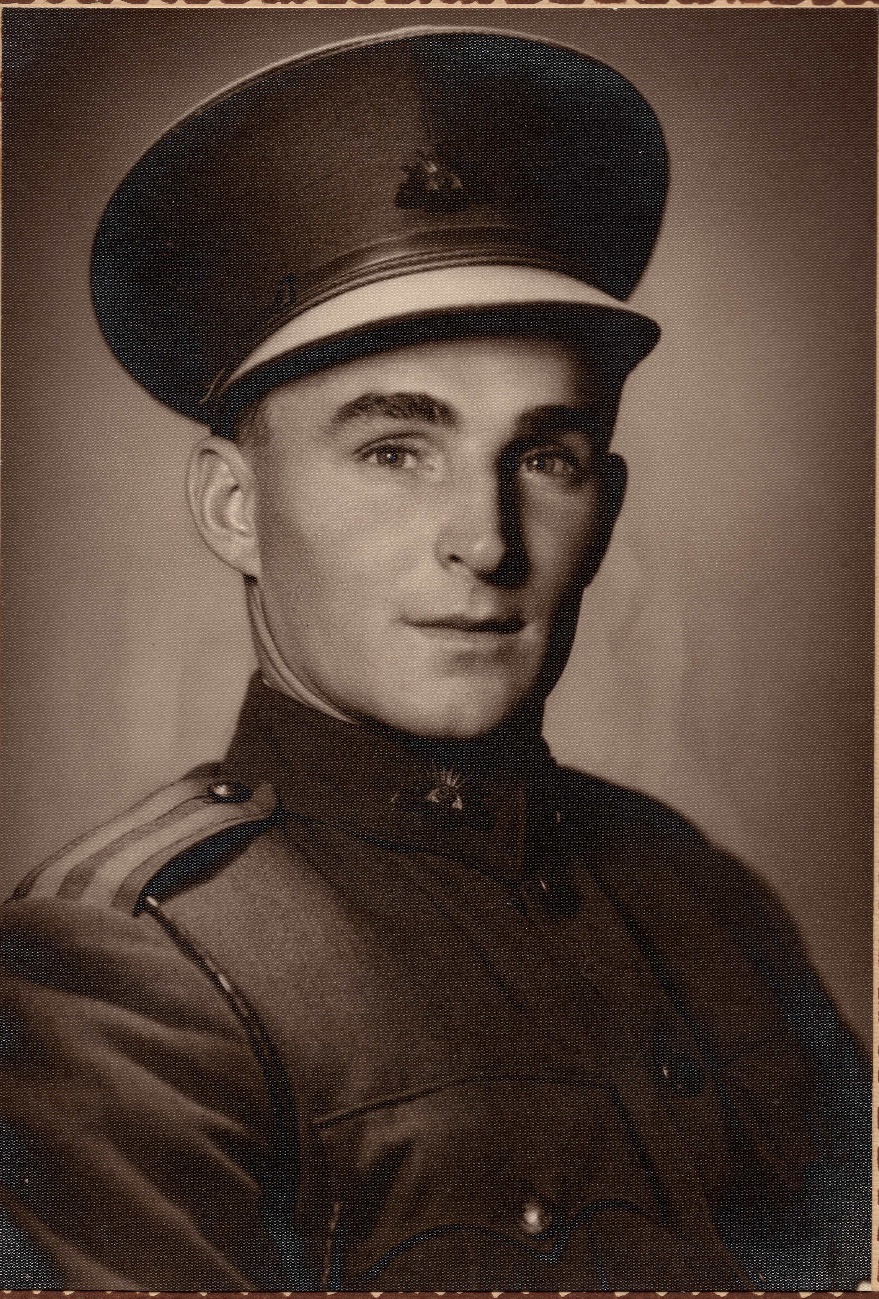
Geoffrey Leonard Hart
The date of 26 April 1915 was a significant day for Australia. On that day, Australian and New Zealand troops were desperately trying to hold on to their small patch of captured ground on the heights above Anzac Cove after landing in the face of intense resistance the day before. Also on that day, a future prominent, long serving, Australian soldier, Geoffrey Leonard Hart was born. The time of his birth is not known but if the time difference between eastern Australia and Gallipoli is taken into account, he may have been born on 25 April Gallipoli time – now recognised as Anzac Day.
His military career, which began in 1933, was to span an incredible four wars before finally coming to an end in 1967. He was the third of four children. His twin older sisters, Lillian May and Amy Elizabeth were born on 19 August 1908. Unfortunately, Lillian May died when she was only 11 days old on 30 August. His younger brother, Oscar Herbert was born on 2 April 1921. Amy married and had seven daughters. Geoff had a close and happy relationship with these nieces.
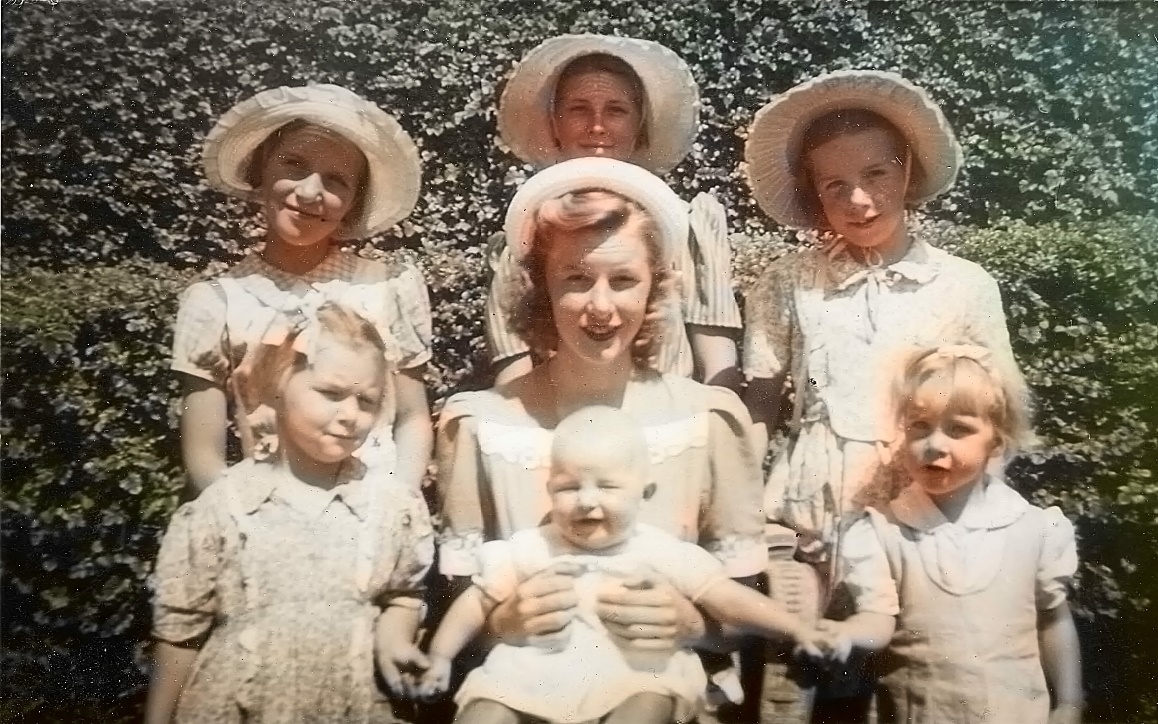
Daughters of Amy Elizabeth, Geoff’s sister.
Back, left to right – Joyce, Gwen, Jeanette
Centre, left to right – Marita, Shirley, Kathy
Front (baby) – Dorothy
The Hart family immigrated to Australia on 24 December 1852 when Geoff’s grandfather, Joseph Hart brought his family out from their home in Bottisham Lode, Cambridgeshire, landing in Victoria to start their new life. Joseph Hart was the father of seven children, including Geoff’s father, Leonard John Hart, who was born in Wollongong on 26 July 1885. Leonard was still in Wollongong when he married Geoff’s mother, Mary Bulch, on 25 February 1908.
Geoff was born in Wollongong and became an apprentice plumber in February 1931. Plumbing obviously did not inspire him as he changed to become an apprentice fitter and turner in February 1932. He is listed as being an oxy welder prior to his enlistment on 29 November 1938.
Geoff joined the 34th Infantry Battalion, Citizens Forces on 26 April 1933 and remained a member of that battalion with a service number of 286717 until 28 November 1938, reaching the rank of sergeant during this period. This unit also carried the title of Illawarra Regiment with a motto of Malo Mori Quam Foedari (I would rather die than be dishonoured) and was to play a part in Geoff’s future military career as the machine gun company from the 34th became part of the 6th Machine Gun Battalion which Geoff was to join.
The Hart family had already contributed towards the military service of Australia with Geoff’s uncle Oscar Herbert Hart joining the 6th reinforcement group of 4th Battalion in 1915. He travelled to Egypt and joined the 4th Battalion with the remainder of the reinforcement group in Gallipoli on 4 August. He was in Gallipoli for only four days before being wounded on 8 August during the battle of Lone Pine. He received a gunshot wound to his hand and a shrapnel wound to his head and was evacuated to Heliopolis.
He never rejoined his unit in Gallipoli as his recovery took several months. He was however able to perform light duties and was discharged from hospital to Zeitoun on 22 August. After spending some time in the 1st Training Battalion, he rejoined 4th Battalion at Serapeum on 1 March 1916. He embarked with the battalion on HT Simla at Alexandria on 23 March and disembarked in Marseilles on 30 March. He continued training with 4th Battalion and was with them during their first major action on the Western Front, the battle of Pozieres. It was during this battle that Oscar was killed in action on 23 July.
Geoff’s younger brother, also named Oscar Herbert Hart, joined 2nd AIF and fought in the Pacific theatre including New Guinea. He was in the Ramu Valley with 6th MG Battalion at the time that Geoff was there but contracted malaria and was evacuated. His date of discharge was 20 January 1945.
Geoff applied to join the Darwin Mobile Force (DMF), Royal Australian Artillery Regiment on 29 November 1938. The DMF was the first regular infantry-based unit established since The Great War. He was successful in his application which was a creditable achievement as more than 5000 men applied for only 245 positions. He attributed his success largely to the fitness and discipline he attained while serving as a lifesaver in the North Wollongong Life Saving Club where he won the ironman competition.
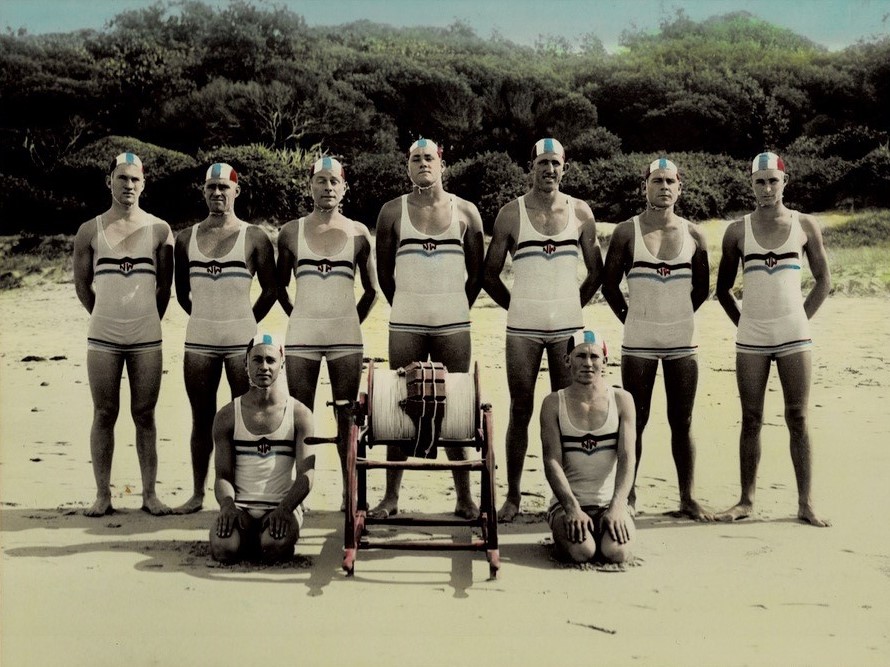
North Wollongong Life Saving Club members. Geoff is on the far right, back row.
While with the DMF, his service number was NP4915. He is listed as being a Presbyterian, height of 5ft 10ins, weight of 180 pounds, with dark complexion and dark hair.
He boarded the SS Montoro at Sydney on 14 March 1939 for Darwin. The ship paused briefly in Brisbane and the unit paraded in the city before resuming the journey.
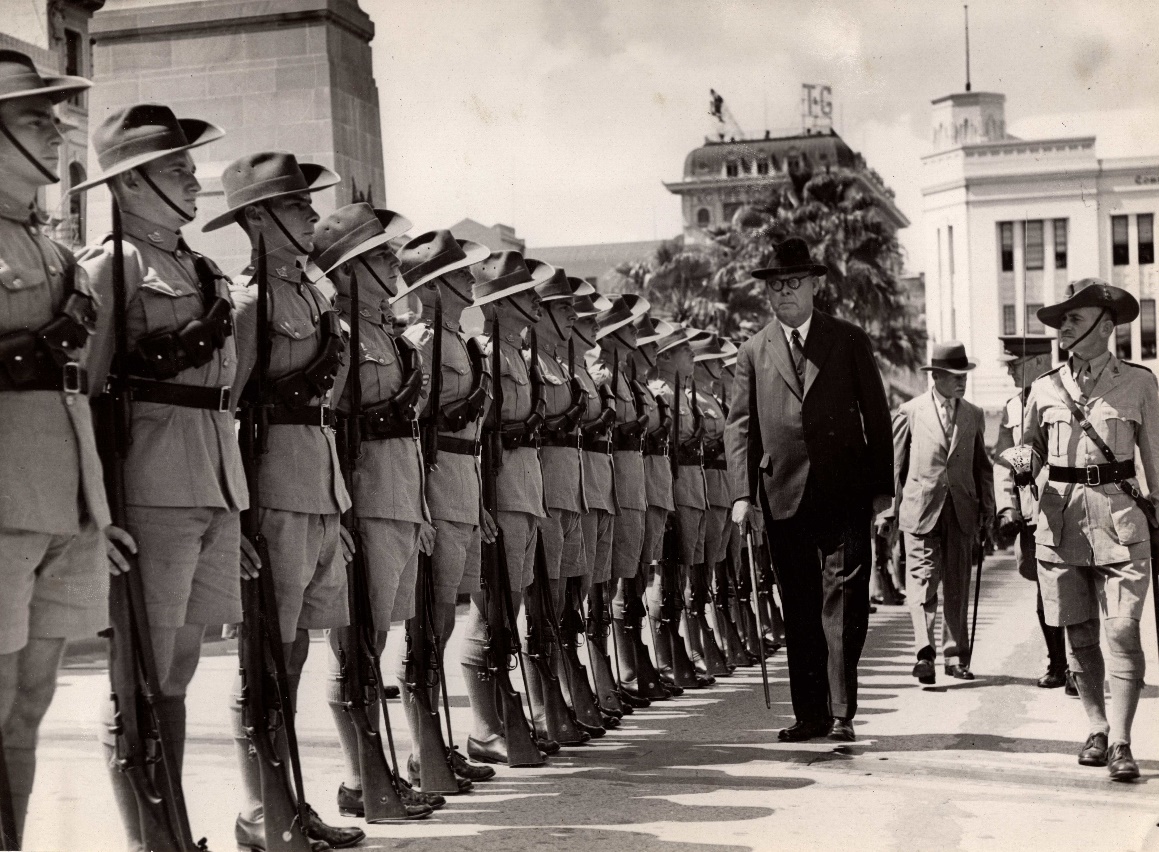
Darwin Mobile Force parading in Brisbane before proceeding to Darwin. Major ‘Bandy’ McDonald is on the right of the picture. Inspecting the troops with Major McDonald is the Brisbane Lord Mayor, Alderman A J Jones. Geoff is the soldier on the far left.
The Brisbane parade was widely reported in the press. The Morning Bulletin in Rockhampton reported on 4 March:
The arrival of the troops in the Square was the signal for a great outburst of cheering which was renewed as the unit came to a halt, with the King George Memorial crowded with spectators as a background.
A salute to the city was taken by the Lord Mayor who, with Brigadier Williams and Major General Neville Cameron (honorary colonel of the Queen’s Own Cameron Highlanders) subsequently inspected the force. Afterwards, the Lord Mayor congratulated Major Macdonald on the wonderful precision of the unit’s movements and upon the physique of the personnel.
Addressing the troops, the Lord Mayor said he wished to thank them for the great compliment they had paid in saluting the city. He was pleased that the troops had been able to march through Brisbane to show the people what a fine display Australian soldiers could make. He congratulated them on their bearing, physique and turn out. In this, he included the 9/49th Battalion Band.
He wished the troops the best of luck in their new sphere of activity at Darwin and he hoped just as sincerely that their services would not be required there on active service.
Geoff’s role while in the DMF was gunner, although he was given the task of driver as well.
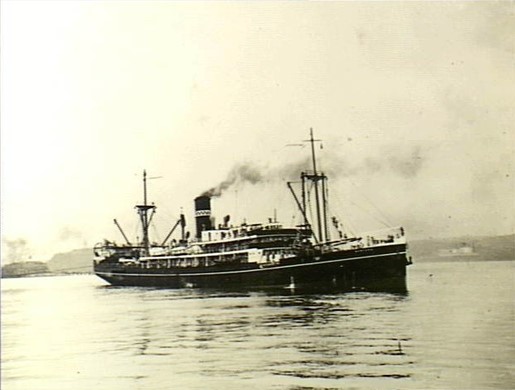
SS Montoro
The DMF’s formation marked a rare departure from the Australian focus upon part-time and volunteer citizen forces and is arguably a key moment in the development of a professional standing army. Due to legislative restrictions at the time, it was established as part of the Royal Australian Artillery and was attached to the 7th Military District in Darwin. As no permanent barracks were available in Darwin, the unit was initially housed in the abandoned buildings of Vestey’s Meatworks. Conditions at the site were very basic and the lingering smell of an abattoir was pervasive.
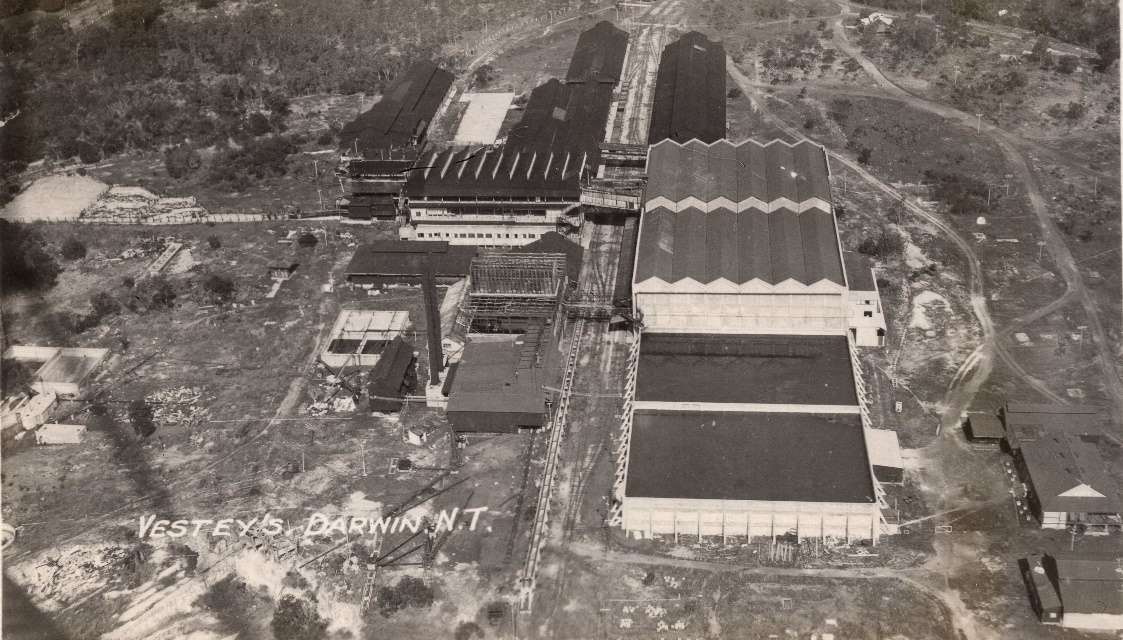
Vestey’s Meatworks, the first campsite of the Darwin Mobile Force

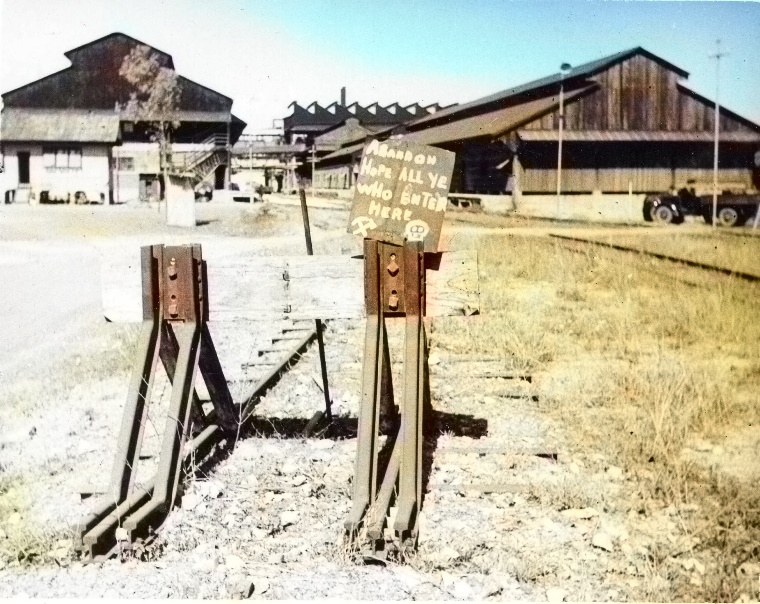
Accommodation at Vestey’s. The sign displays the typical Australian ‘wag’ opinion of the accommodation.
The force was used to garrison Darwin until it was disbanded in 1941 and its members transferred to other units following the creation of the 2nd AIF. While in the DMF, Geoff was affectionately called Steve Hart after the famous Kelly Gang bushranger.
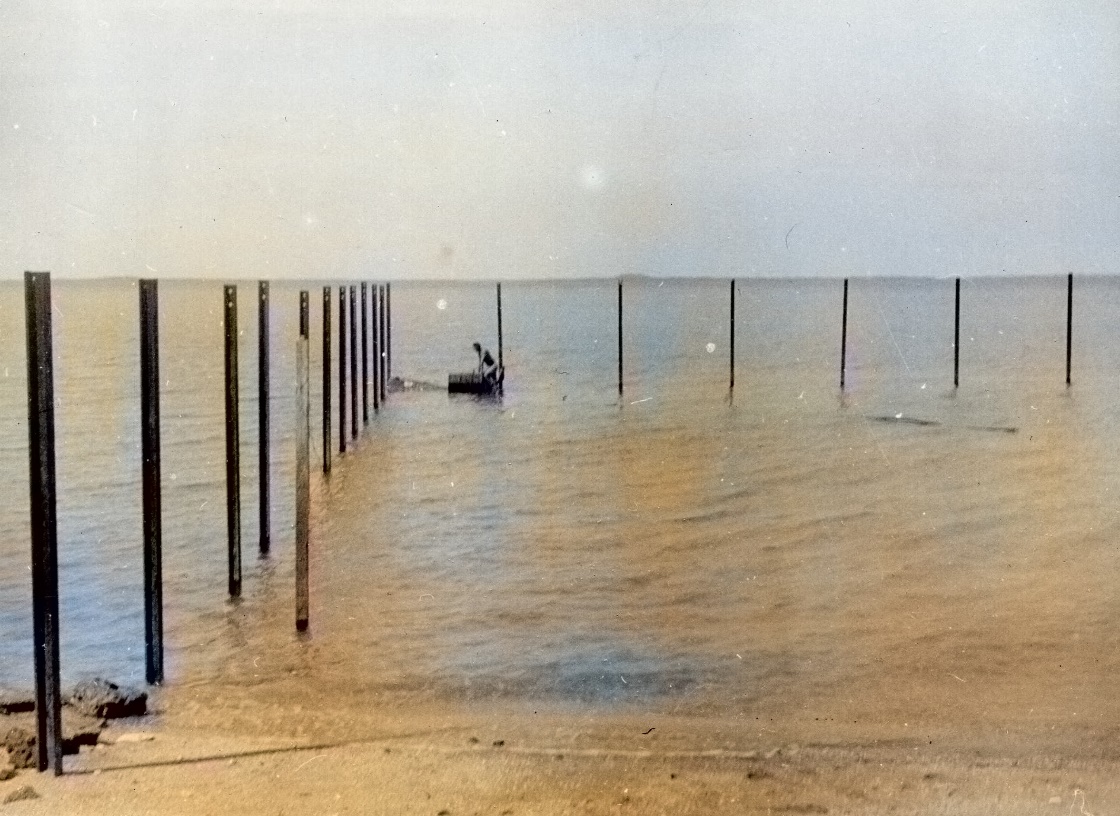
Swimming enclosure constructed by Geoff on the beach adjacent to Vestey’s. His previous experience as a surf life saver may have prompted this construction.
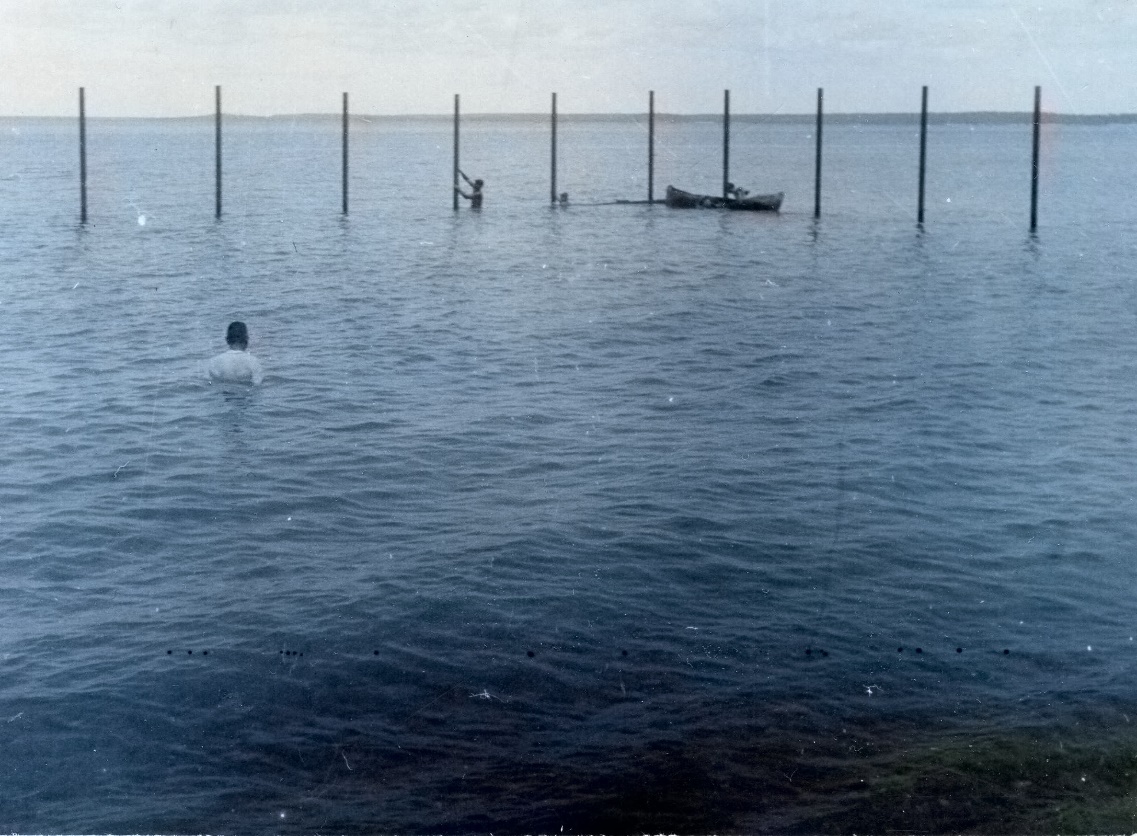
Any excuse to go for a swim. The construction of the swimming enclosure provided the DMF troops with opportunities to cool off in Darwin’s tropical climate.
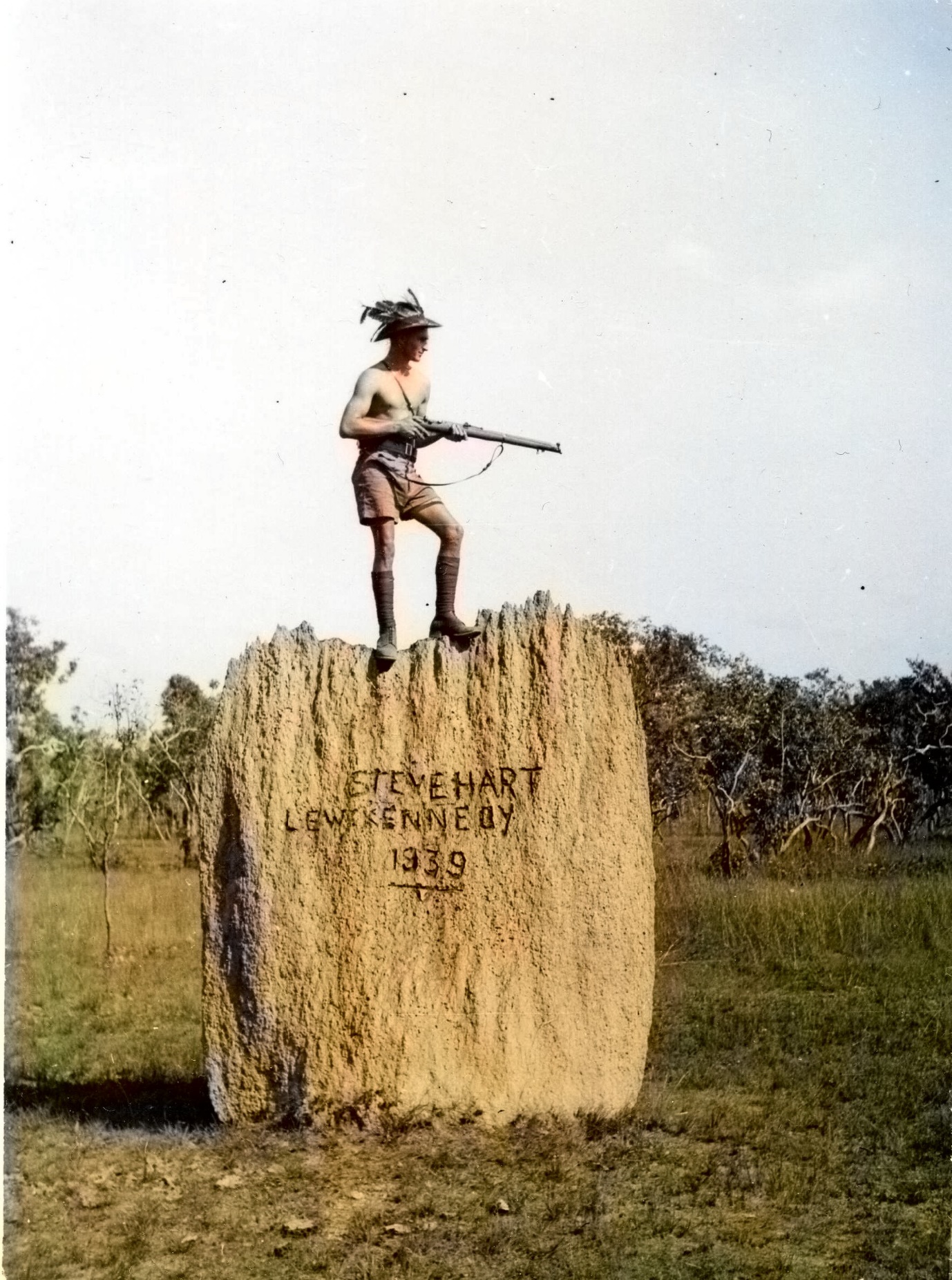
Time out for some skylarking as ‘Steve’ Hart poses atop a huge anthill near Darwin. Lt Hassett was probably aware of these antics which would appear to have coloured his judgement in Korea.
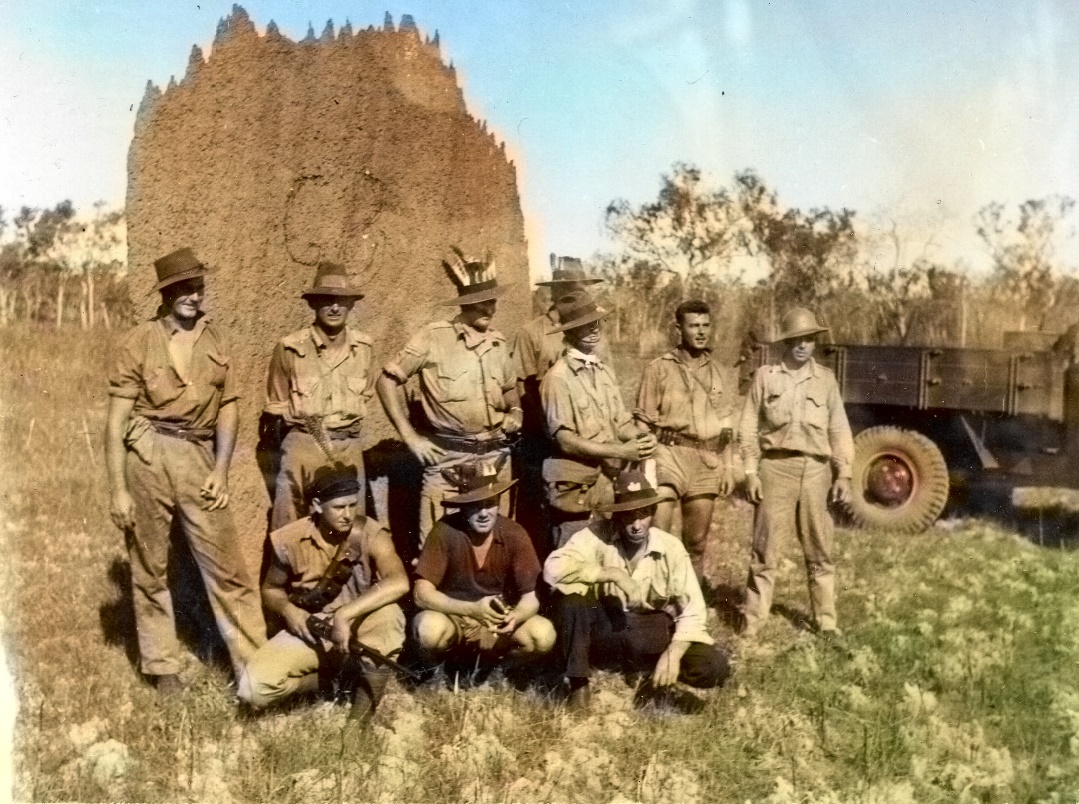
Partners in crime. Members of the DMF, including Geoff (feathers in hat back row) posing in front of a giant termite mound in the Northern Territory. The initials GB carved into the mound could refer to one of the four members of the DMF with these initials (G. Bannon, G. Bingham, G. Bosworth and G. Burgess)
Although the primary role of the DMF was the defence of Darwin, it also provided command and training experience for graduates from Royal Military College, Duntroon and to members of the Australian Instructional Corps (AIC). It was to the AIC that Geoff was transferred on 25 March 1940.
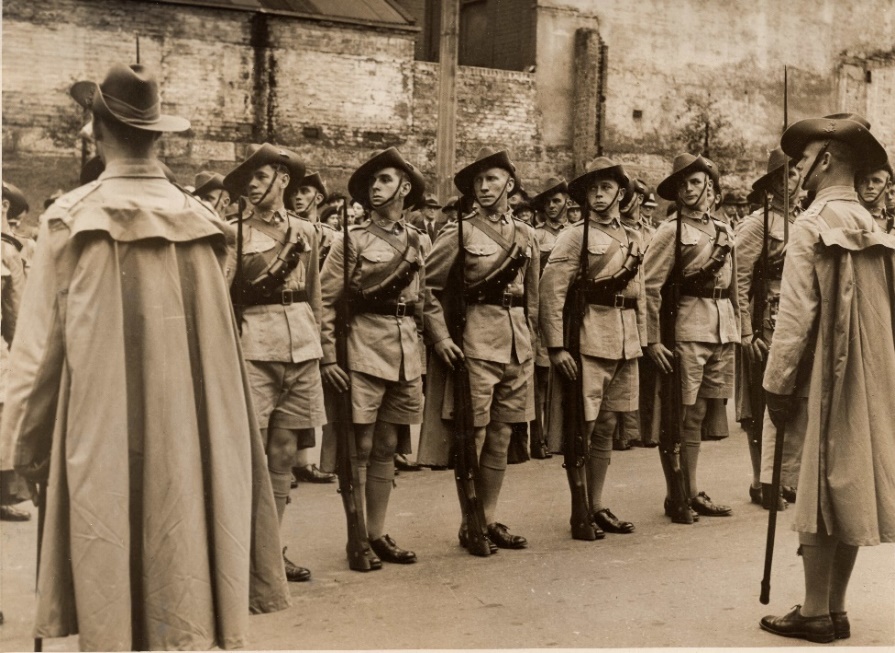
Darwin Mobile Force on parade – note the distinctive capes (known colloquially as Mandrake capes) only worn by the DMF
Geoff did not carry his rank of sergeant from 34th Battalion to the DMF, arriving as a private, but was soon on the promotion path again. He was appointed lance corporal on 5 October 1939. On 25 March, he was transferred to AIC at Randwick and promoted to acting sergeant. This appointment became permanent on 25 April 1940. He was then promoted to temporary warrant officer on 3 July and spent the next two and a half years as a WO2 instructor. He was released to the War Establishment of 21 Field Regiment at Rutherford on 19 February 1942 in his first role as RSM, where he remained until 11 May.
His next transfer was to 14 Motor Regiment, also at Rutherford on 12 May where he again performed the role of the RSM. From there, he moved to the Tank Transport Company of 3 Aust Army Motor Brigade on 7 July and then posted back to 14 Motor Regiment on 28 August. He remained in this position until his transfer to the AIF on 27 October 1942 and was allocated a new service number of NX171160.
Geoff’s first posting in the AIF was as RSM to 6 Australian MG Battalion on 9 December 1942. This was a regular battalion formed by combining the MG companies of several militia battalions, one of which was 34th Battalion, Geoff’s original unit, so he would have been in the company of past acquaintances. He was appointed A/WO1 on 5 April 1943. Training was conducted around Wollongong and Shellharbour until, on 16 July, the battalion entrained for Townsville in preparation for embarkation to New Guinea. Geoff, along with the battalion embarked on the Taroona on 31 July, disembarking at Port Moresby on 2 August.
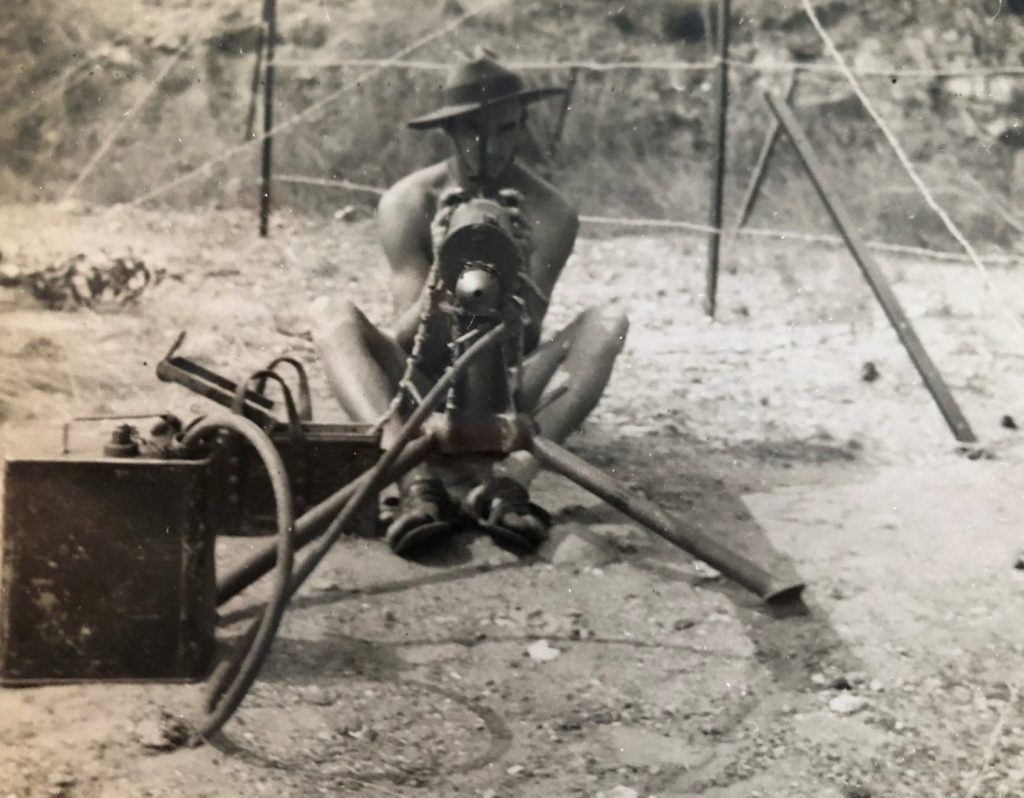
Geoff demonstrating the operation of a Vickers Medium Machine Gun. 6 MG Battalion was equipped with these guns.
Upon arrival, the battalion undertook defensive duties around Port Moresby, mainly at Ward’s Airfield. Two months later, it was sent to Donadabu and attached to the 7th Infantry Brigade. On 26 September, Geoff’s WO1 rank was confirmed with Brigade Command and a few days later, the battalion was attached to 7th Division. With the exception of one company that stayed in Port Moresby, the battalion joined the Ramu Valley-Finisterre Range campaign. The role of the battalion during this campaign was to defend Gusap Airfield during heavy fighting around Shaggy Ridge.
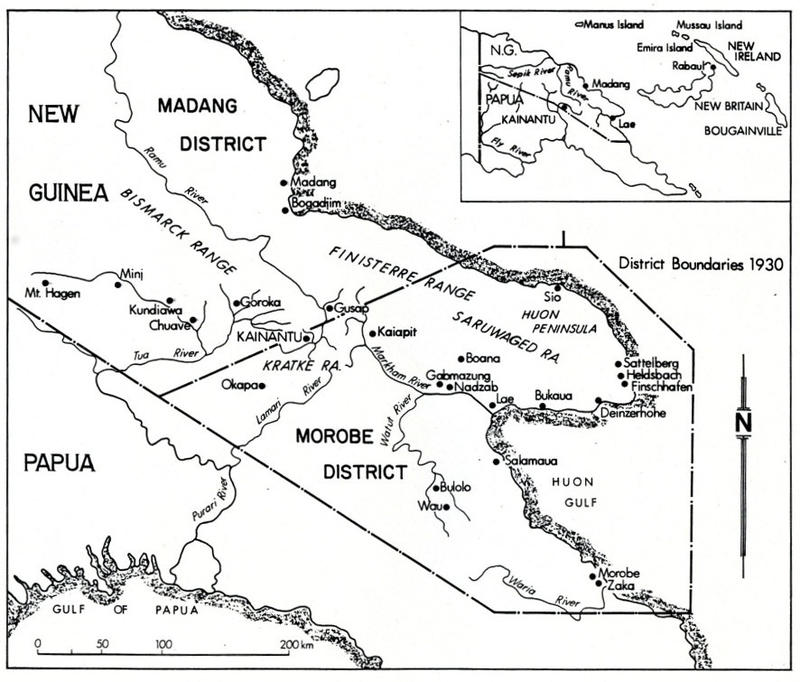
Ramu Valley-Finisterre Range area of New Guinea
Constant patrolling was required to ensure that the Japanese were not close enough to pose a threat to the airfield. As well as the Japanese, these patrols had to constantly be vigilant against attacks from natives who were not always friendly towards the Australians. On 20 December, 30 arrows were discharged by natives at a patrol.
Two Japanese air attacks on the Gusap Airfield were recorded in the battalion war diary. The largest was on 15 November, when 25 enemy bombers with fighter escort attacked and dropped 30 bombs. Twenty of the enemy planes were destroyed.
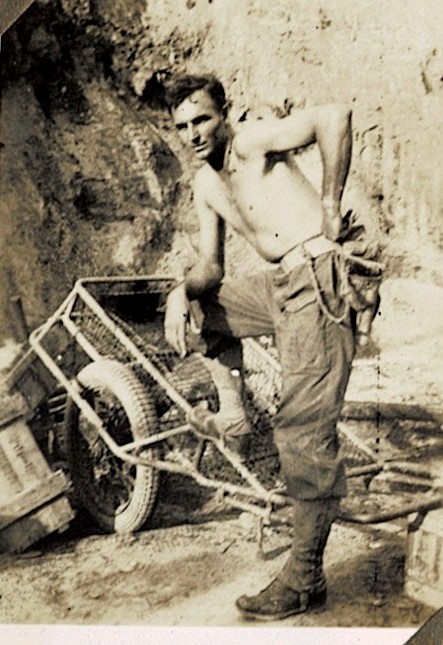
Geoff in New Guinea 1943-44 (exact date unknown).
Geoff took advantage of his skill as a marksman while in the Ramu Valley. In his book Machine Gunners, John Campbell states: “Geoff Hart and Tom McDermott tried to supplement their diet with duck. Unlike Colonel Hearne, they didn’t have a shot gun and used their .303s. Tom scored a cricket ‘duck’ whilst Geoff proved a better shot and several real ducks were bagged.”
Malaria was a major problem around the airfield and, as malarial cases were withdrawn, the company based in Port Moresby was utilised as a reinforcement pool until it had used all of its personnel and was disbanded completely. The battalion was relieved from Gusap Airfield in March 1944 and returned to Dobodura by air. It was then moved to Semina where they set up camp to await available shipping for its return to Australia. Geoff and half of the battalion embarked on the Katoomba at Buna on 12 March, disembarking at Townsville on 19 March.
Unfortunately, Geoff was one of the huge number of soldiers who contracted malaria while in New Guinea and upon disembarkation, he was immediately transferred to 2/14 Army General Hospital (AGH). He remained there until 29 March when he was transferred to 116 AGH until being discharged and sent on leave on 2 April. He remarked that even while in hospital in Townsville he had not escaped the war as he was there when Townsville was bombed by the Japanese.
After leave in Sydney he rejoined his unit but, on 12 June was evacuated to 113 AGH with a recurrence of malaria. He was discharged from 113 AGH on 20 June and transferred to the General Details Depot (GDD) in Sydney. He remained in GDD until he rejoined 6 MG Battalion on 22 June. His relief was short lived however as he was again hospitalised, this time to 120 Australian Specialist Hospital with a ‘not yet determined’ condition on 14 July. He was sent back to GDD on 21 July. He rejoined his unit on 29 July.
His illnesses continued however and on 24 September he was evacuated to 63 Army Combined Hospital (ACH) with a condition diagnosed as Pyrexia of Unknown Origin. He remained in 63 ACH until the Pyrexia was determined to have been caused by Malaria. He was eventually discharged and rejoined his unit on 10 October.
The next transfer for Geoff was to the 2nd Australian Recruit Training Brigade (2 ARTB), Jungle Warfare group at Canungra on 6 November 1944. It is possible that he was transferred to Canungra at the request of Major Alex (Bandy) McDonald who had been the commanding officer of the Darwin Mobile Force while Geoff was a member and after serving in Syria, had been transferred to command the Jungle Warfare Group in Canungra. Geoff remained in this unit until transferring to 2/2 MG Battalion on 18 December and then to 2/23 Infantry Battalion on 6 January 1945 as RSM.
The 2/23 Battalion had already been very heavily involved in operations in the Middle East and New Guinea and at the time of Geoff’s transfer was training in the area around Ravenshoe on the Atherton Tablelands. They were assigned, as part of the 9th Division, to participate in Operation Oboe, the capture of Tarakan in Borneo. The battalion, as part of 26th Brigade, moved down to Cairns from Ravenshoe and on 3 April embarked on the Lindley M Garrison for Morotai, disembarking there on 17 April. Geoff, as RSM of the battalion, conducted preparatory operations on Morotai prior to landing at Tarakan in May.
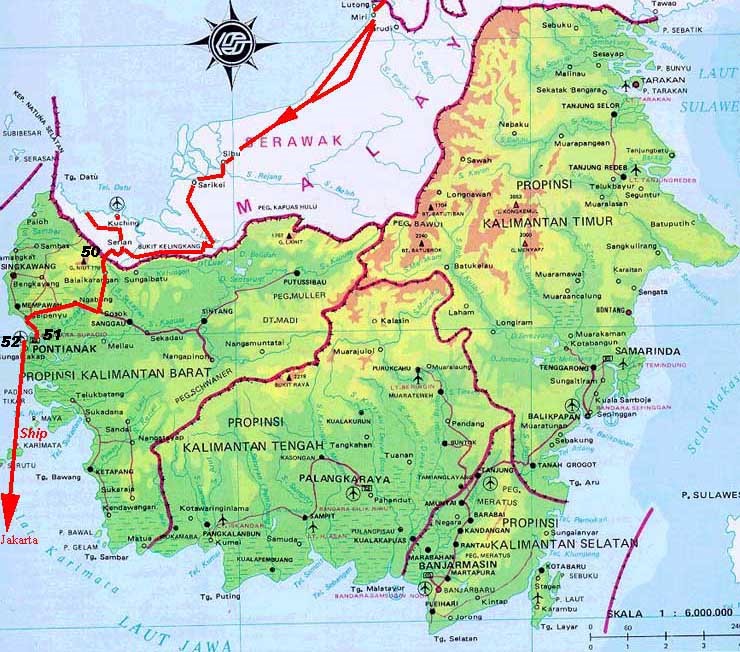
Kalimantan region of Borneo. The island of Tarakan is in the top right corner of the map.
The 26th Brigade comprised 2/23, 2/24 and 2/48 Infantry Battalions, as well as 2/9 Armoured Regiment with 18 Matilda tanks and the 2/7 Field Regiment with 24 twenty-five pounder guns. The allied plan was to transform Tarakan into a major base within days of the landing.
The battalion was assigned a lead role in the landing and after negotiating the muddy beaches, advanced into Tarakan town. Several actions were fought during the day as they came up against Japanese pillboxes and snipers. Despite the heavy opposition, the battalion secured almost all of its objectives for the first day. Over the next few days, it also fought actions to secure the high ground around the beachhead and airfield.
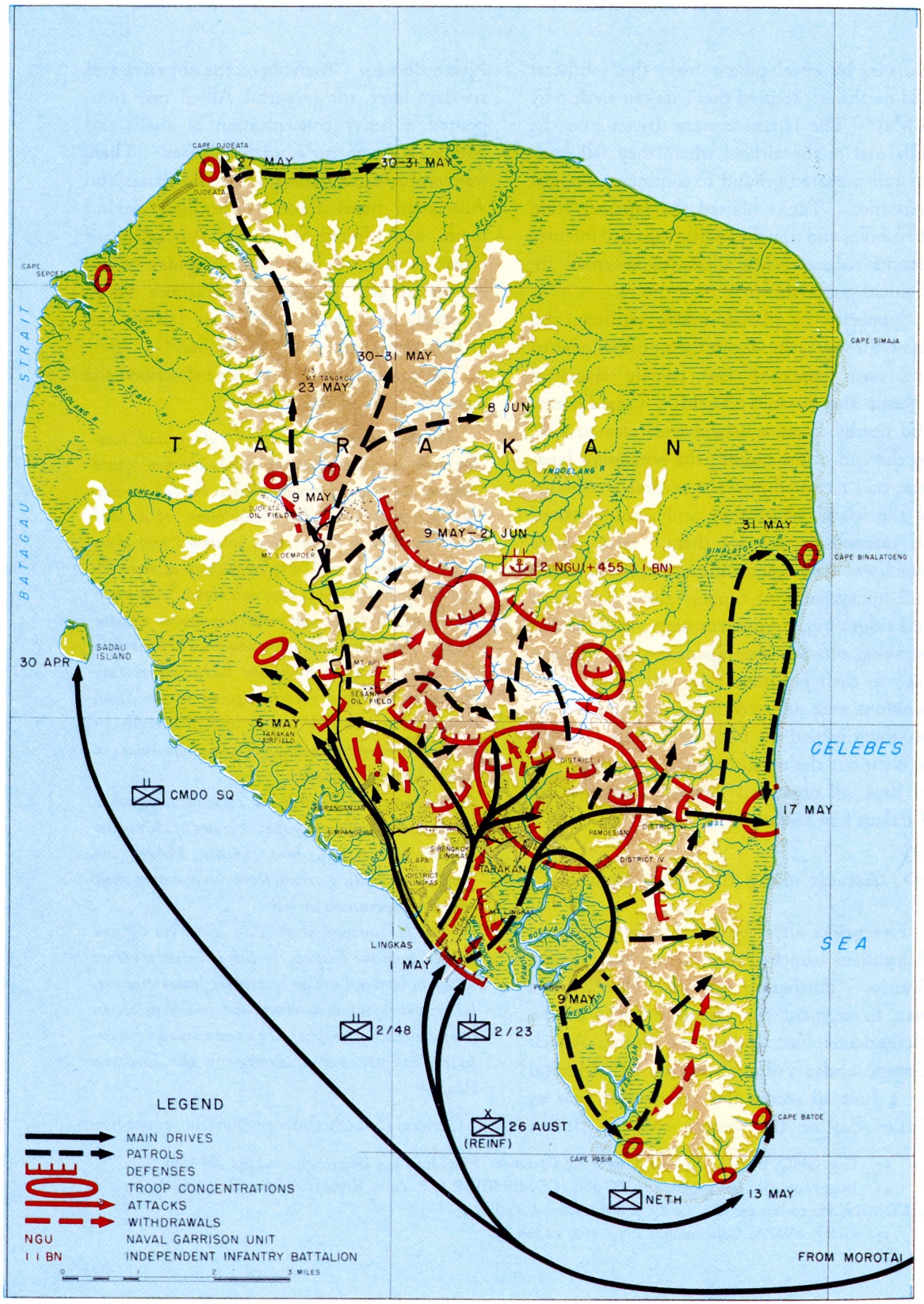
Map of Tarakan showing the areas of the landings and the main battle areas.
The action remained intense throughout May and June as the battalion advanced to clear enemy forces from the steep inland areas of the island. Despite plans for a swift conquest, it took until the middle of June for the fighting to subside and the battalion then began mopping up operations in the central sector of the island.
Japanese stragglers were still being cleared in July. The battalion was still on the island when hostilities ceased on 15 August prior to the official Japanese surrender on 2 September after the dropping of the atomic bombs on Hiroshima and Nagasaki.
Historians now generally agree that the battle for Tarakan, in which 251 Australian soldiers were killed and a further 669 wounded, was not necessary. The major objective was the capture of the airfield to quickly allow expanded air operations. The airfield was, however, so heavily damaged that ultimately it could not be repaired in time to be of any use. The battalion was gradually reduced in size as its members were transported back to Australia and demobilised.
During the fighting at Tarakan, Geoff captured and brought home a Japanese flag. The flag, still a family possession, contains the names of many Japanese soldiers written around the red centre. It is poignant to consider that, given the Japanese casualty rate during the battle of Tarakan, every Japanese soldier who signed the flag would probably have been killed.
While on Tarakan, Geoff rescued a large monkey that had become trapped in a building. Being an animal lover, he kept the monkey as a pet, however the monkey would not allow anybody to come near it, only Geoff and his batman. Interestingly, a visiting war correspondent took a photograph of Geoff and his batman with the monkey and the photograph was published in the press with the caption stating that this was a “pet orangutan” This photo remains in the Australian War Memorial (AWM) archives with the erroneous caption.
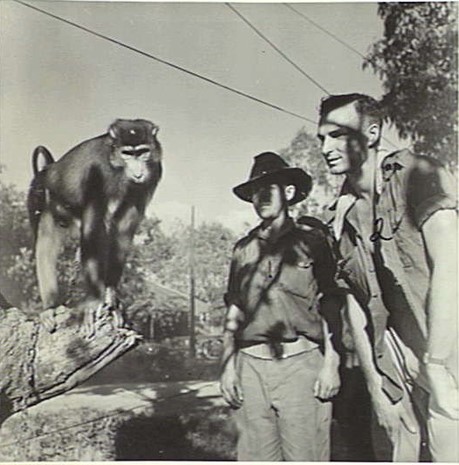
Geoff and his batman with the monkey they rescued on Tarakan.
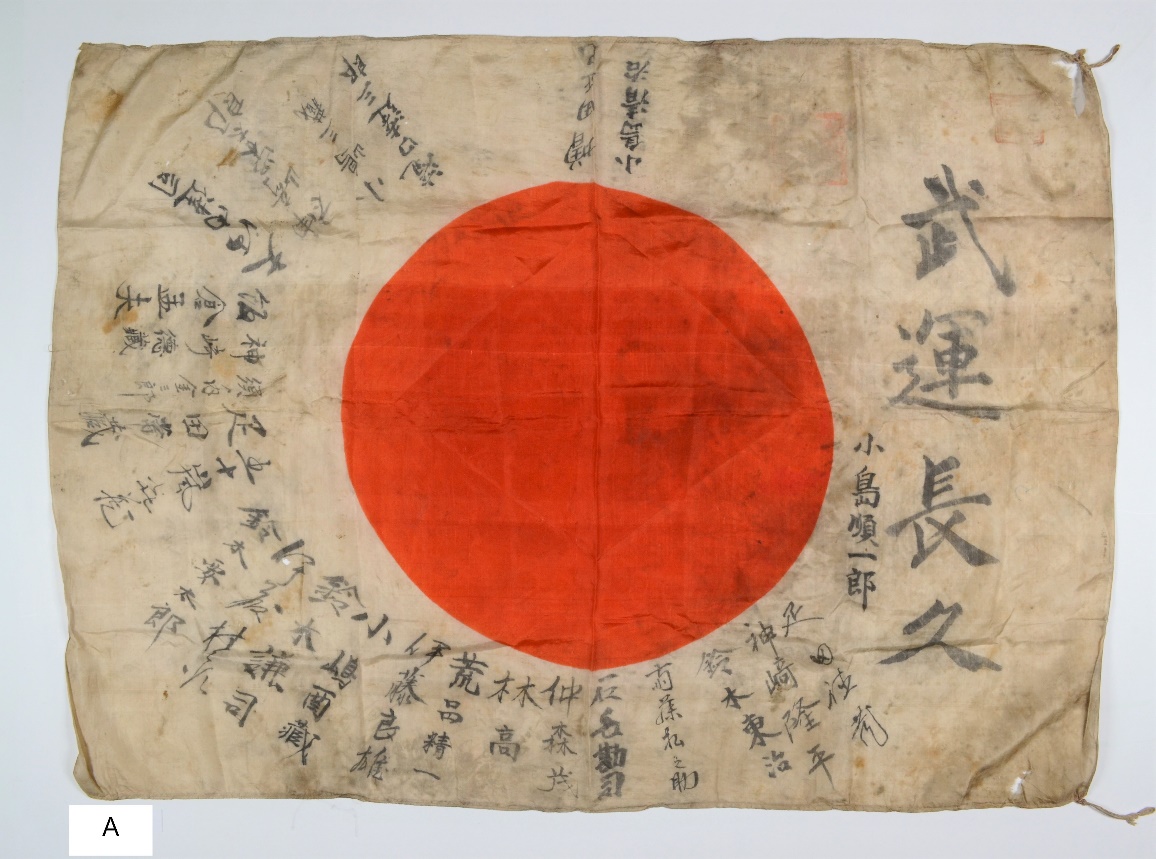
Japanese flag captured on Tarakan adorned with many Japanese names. This flag is now available for viewing at the Maryborough Military and Colonial Museum.
Geoff was transferred to Officer Cadet Training Unit (OCTU) for officer training on 21 August and, on 25 August, he was transported across to Morotai and then flown back to Australia, prior to the Japanese surrender. He arrived in Townsville the next day. He was an attendee in Course 19 for OCTU but was withdrawn from the course on 20 December. He was then transferred to the General Details Depot to await re-allotment.
The next major event in Geoff’s life was his marriage to Nancy Wanda Kay on 5 January 1946. The newlyweds moved in with Nancy’s parents, Alf and Vera Kay at 38 Harrison Ave, Eastwood until they were allocated an army house in Yeend St, Merrylands. They subsequently purchased Nancy’s parents’ house and moved back to Eastwood where they lived until Geoff’s next army relocation.
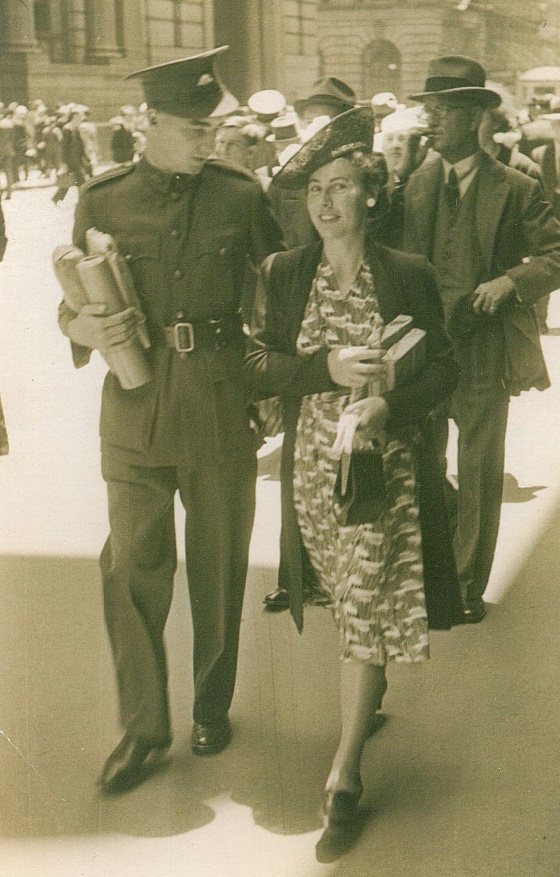
Geoff and his wife Nancy Wanda
Returning from leave, Geoff was transferred to NSW Line of Command on 22 February 1946, transferred to HQ Recruit Training Centre on 4 April and attached to 5 Recruit Training Battalion on 5 April. He remained in this unit until 18 July and was then transferred to 2/46 Armoured School which was a component of the Australian Armoured Corps. He was a member of this unit until 3 February 1947 when he was transferred to Royal Military College (RMC), Duntroon, resulting in Geoff’s relocation to Canberra.
His family remained in Sydney and only saw him occasionally. Shortly after this move, Geoff’s responsibilities again expanded as he became a father on 28 February with the birth of his first son Peter John.
In September 1946, the Australian Government announced that Australia would have an interim Army of 39,000 and a permanent military force of 17,954 including 4,000 reinforcements. Geoff was destined for the interim army and was transferred to it on 1 July 1947 with the service number of NX171160. He continued as an instructor at RMC until 9 December 1949 when he was posted as RSM to 1st Battalion Royal Australian Regiment (1 RAR).
On 22 June 1951, he re-enlisted for a further six years and was transferred to the Australian Regular Army. He remained with 1 RAR until 3 October 1951 when he was transferred to Reinforcements Special Force and sent to Sydney prior to being sent overseas once again.
The Korean war had by this time been under way for more than a year and Australia was heavily involved. The initial North Korean advance was first held by the UN (mainly US) forces in front of Pusan and then shattered by the amphibious landings at Inchon. The charge of the UN forces north of the 38th Parallel had then in turn been held and reversed by the entry of Chinese forces on the side of North Korea. The front then see-sawed as one side and then the other gained advantages.
Australia was represented by the 3rd Battalion, Royal Australian Regiment (3RAR) as well as by naval and air units. It was attached to the Commonwealth 28th Brigade and fought several bloody battles during this early war phase, including the battle of Kapyong in April.
Geoff travelled to Sydney where he emplaned on 5 October and flew to Japan (via Darwin), arriving there on 7 October. He remained in Japan until 19 October when he emplaned for Korea and was appointed RSM of 3 RAR. As such, Geoff became the only person to be the RSM of 1 RAR and 3 RAR during their army career.
This appointment was challenged by the commanding officer of 3 RAR, Lt Col F G Hassett. Upon hearing that Geoff had been appointed as the RSM of his battalion, he advised that: “…he considers Hart lacks sufficient drive and strength of character for appointment to RSM”. He then advised that, if no other warrant officer was available for appointment, he proposed to promote an existing member of 3 RAR.
The response from Army stated that: “Hart was selected as a result of correspondence between Hassett and Daly (commander 28th British Commonwealth Brigade). He was the best available at the time of selection. As Hart has been under orders for movement since 28 August 1951 and is due to emplane for Japan, we consider it is not justified in cancelling his move at this juncture. We desire he be given trial as RSM 3 RAR and, if after reasonable time he proves unsatisfactory, we request you forward a recommendation as to his future employment.”
Interestingly, the recommendation was based on correspondence from Hassett who then rejected him when appointed. The flow of the correspondence indicates that Geoff was selected by the army based on Hassett’s communicated requirements. Following the communication exchange, Brigadier Campbell, Administrative Commander in Japan, instructed Hassett to “Send me copies of all such correspondence in future to obviate the repetition of this misunderstanding”.
It is noteworthy that Hassett served in the Darwin Mobile Force with Geoff. He held the rank of lieutenant at that stage of his career. It is possible that an interaction between the two men at that early stage of their respective careers coloured Hassett’s impression of Geoff. Like Geoff, he went on to have a long and proud career in the Australian Army, culminating in his appointment as Chairman of the Defence Force Staff and the rank of general on 24 November 1975.
Geoff served under him for the next 12 months in Korea without any recorded complaint from Hassett so it is clear he met his expectations as an RSM in an active war situation. When asked for details of Geoff’s repute following his death in 1999, Hassett stated, “The RSM is responsible for morale and well-being of the other ranks – he is the senior other rank. The wartime role includes ammunition supply and evacuation of casualties. Geoff took over from a very good RSM who set a very high standard. Geoff was able to match that standard.”
This is further reinforced by a letter received from Lt General Wells, Commander in Chief, British Commonwealth Forces, Korea on 28 February 1953. It stated:
2/772 WO1 Hart GL
Royal Australian Infantry
Your devotion to duty has been brought to my notice. I wish to thank you for your valuable services and by the issue of this certificate to signify to you my appreciation of the fine example you have set. I have given instructions that a note of your devotion to duty shall be made in your Record of Service.
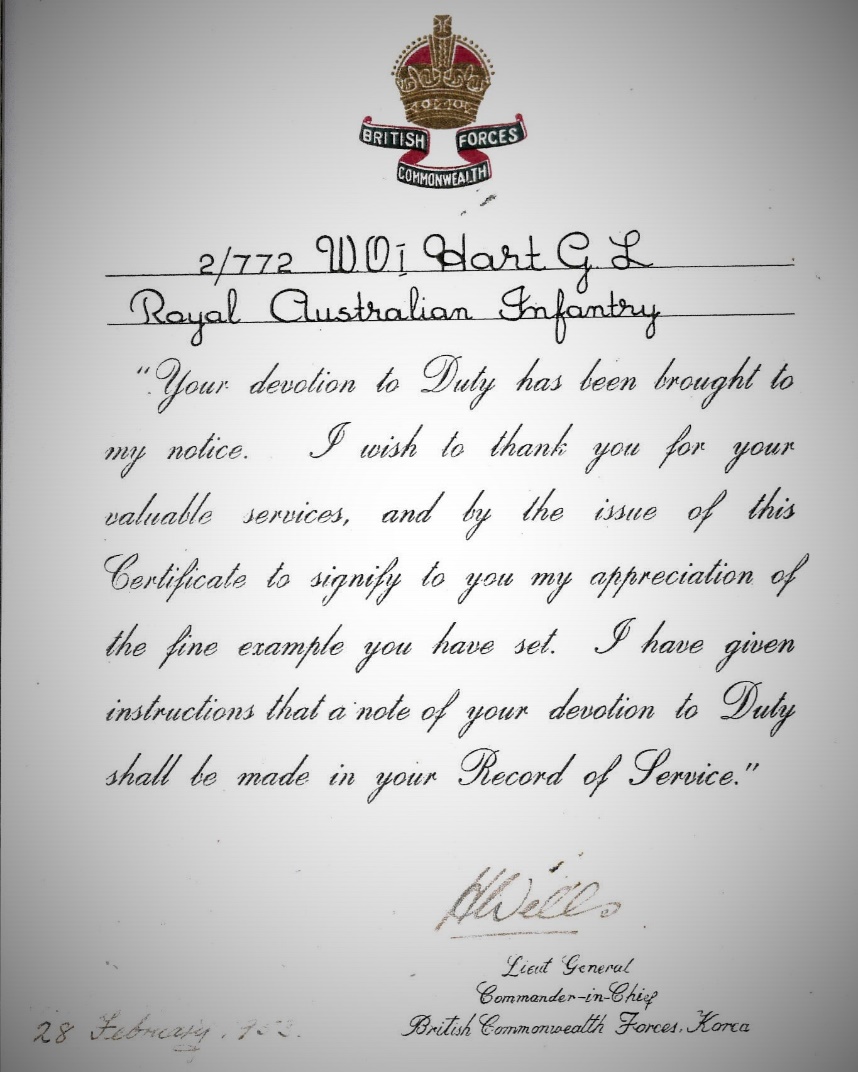
Certificate of Appreciation from Lt Gen Wells.
Geoff had joined 3 RAR in the concluding phases of the Maryang San campaign during which it had fought ferociously and successfully for Hills 217 and 317. Following the main fighting, the battalion was withdrawn to rest and refit and while in this position, heard the news that both hills, taken at great cost and effort had been lost to the Chinese.
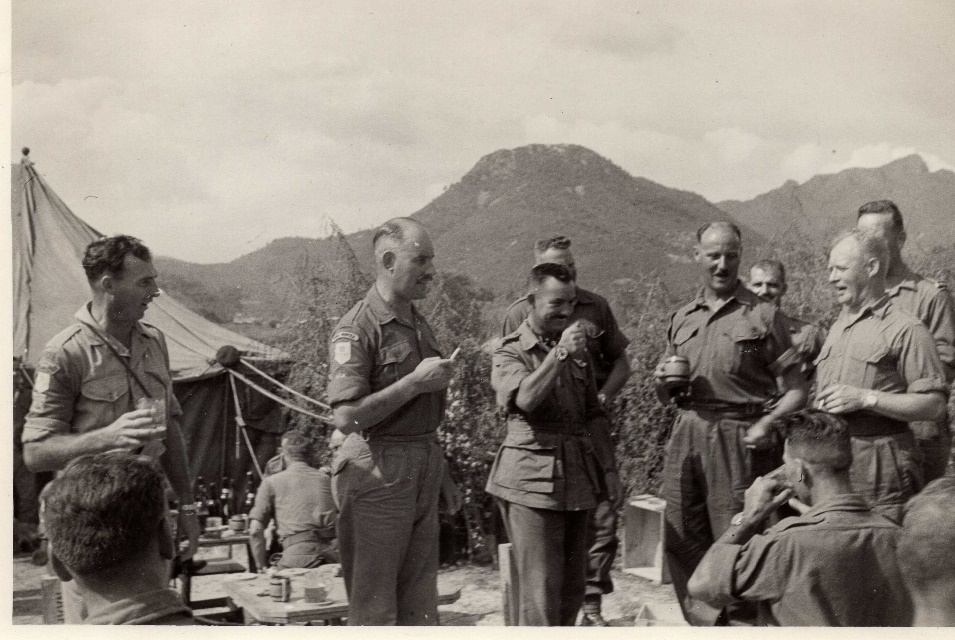
Geoff (left) enjoying a rare drink in Korea to celebrate the completion of the Imjin River bridge by Australian engineers (see below).
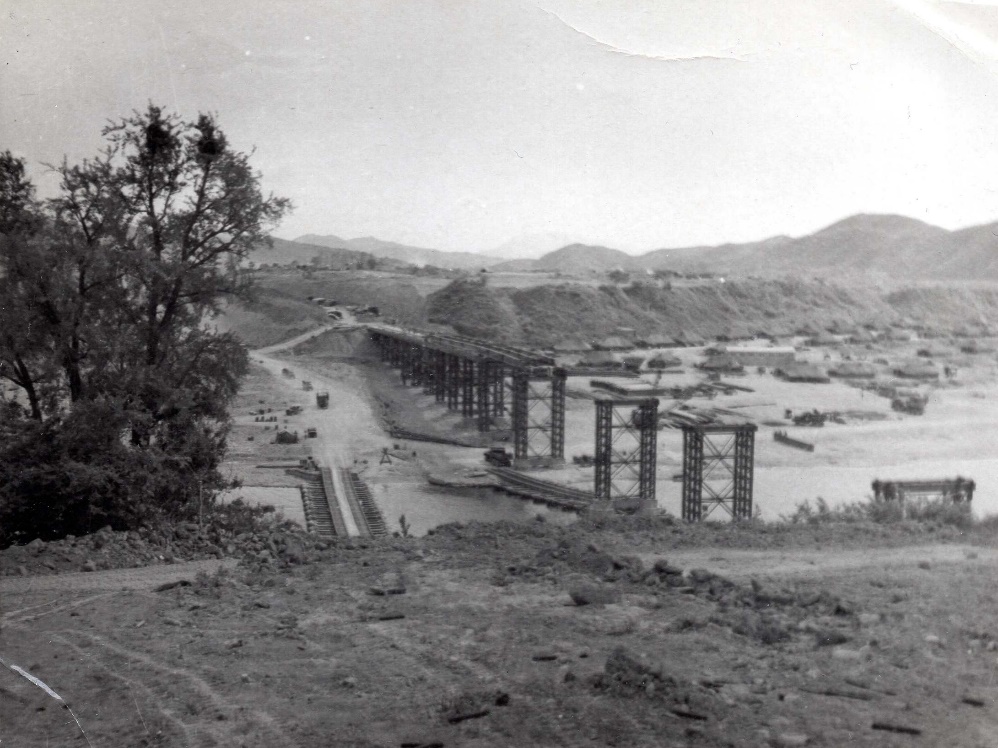
Pintail bridge across the Imjin. The bridge to the left was the one constructed by Australian engineers.
The battalion experienced good weather during November but this was of little comfort to the soldiers of 3 RAR. Following the recapture of Hills 217 and 317, the Chinese could now look down on the brigade defences and no one was safe from harassing mortar fire, sporadic artillery and snipers. Cases of shell shock and battle fatigue increased and the installation of barbed wire defences and the digging of trenches had to be done at night.
The Chinese launched strong attacks during November, but these were primarily directed at other Commonwealth battalions, mainly the Shropshires and Leicesters. In late November, the Chinese probed the defences of the battalion and captured some outposts, but these were recovered the next day.
On 29 November, the battalion position was taken over by the Philippines battalion and the entire 28th Brigade was withdrawn from its sector. Winter set in solidly and temperatures dropped below zero. Living in the trenches was taking its toll. An outbreak of Manchurian Fever occurred and Hassett became very concerned about the health of his men. The troops were deloused, poison baits for vermin were laid and every care was taken with garbage. The misery was somewhat relieved by a Christmas celebration that included gift parcels from Australia and a dinner in the bunkers of the Shropshires. Interestingly, they also received Christmas cards from the Chinese urging peace and suggesting that bombs and bullets would never break the spirit of the Koreans or the Chinese. A ceasefire was declared while peace negotiations occurred and the battalion spent the entire winter repairing and strengthening defences and patrolling no man’s land.
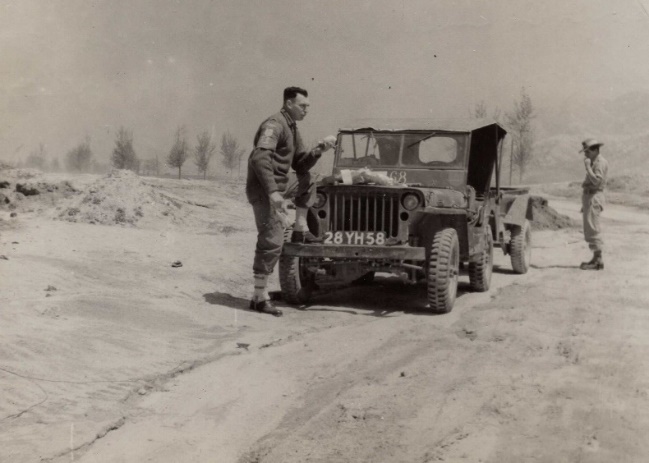
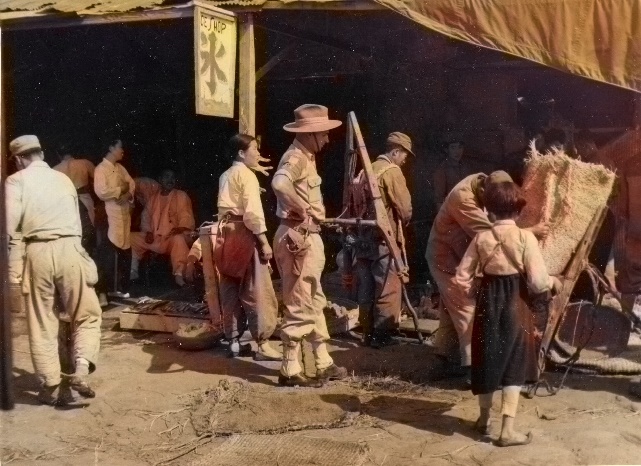
Geoff in a snow proof clothing in Korea – 1952. Caption on back of photo reads, “This is my jeep on way to Seoul. I’m eating a melon and no I’m not fat, it’s the snowproof jacket”.
And Shopping in Seoul.
The largest battle during this time took place on January 26 when the battalion decided to celebrate Australia’s national day by attempting to recapture Hill 227 which they had nicknamed Fanny Hill. They were repulsed by a much larger force and lost seven killed and nine wounded. As the winter waned, the battalion set itself the goals of controlling no man’s land and learning as much as possible about the enemy positions. To this end, an intensive patrolling plan was executed and the two Australian battalions (1 RAR had now joined the brigade) carried out more patrols than any other unit in the brigade.
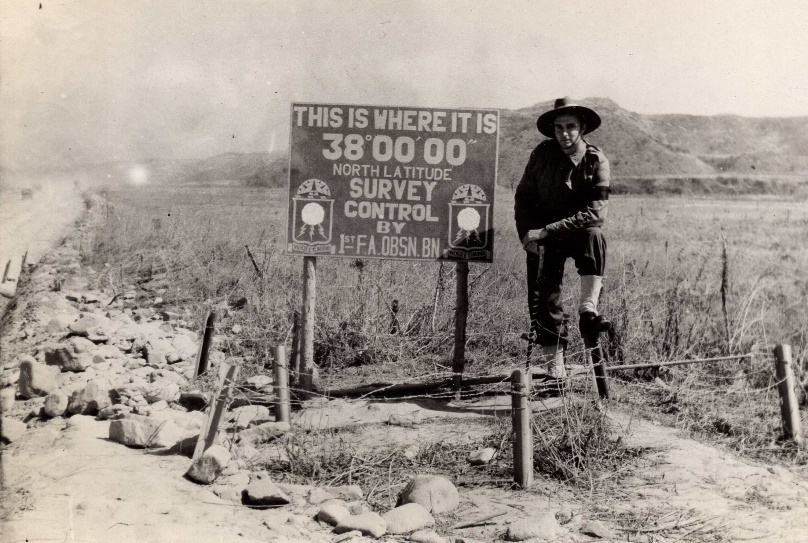
Geoff on the 38th Parallel – Korea 1952
The onset of spring and summer was dramatic. Snowdrifts and icicles melted, water dripped and ran through the emplacements, laboriously dug trenches caved in and the roads and tracks turned to mud. Senior allied officers were reminded of conditions on the Somme. Mosquitoes and rats arrived in droves, bringing fever and malaria. Washing in the front line was impossible and the men had to be rotated to the rear for ablutions. In the position of RSM, Geoff would have been responsible for much of the administration and conduct of the activities required to keep the men in fighting condition and the battalion combat effective.
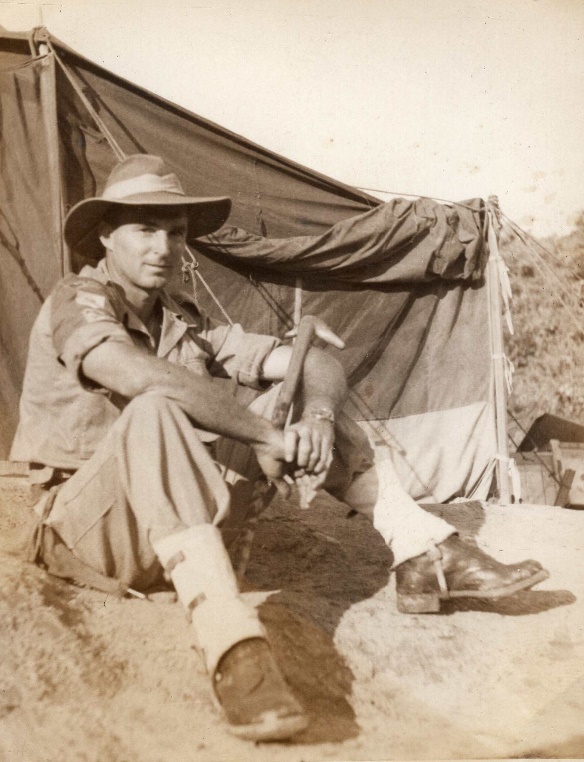
A moment of rest – Korea 1952
On 28 March 1952, news arrived from Australia that Geoff was again a father with the birth of his second son Keith Geoffrey. This news would have been most welcome amid the harsh conditions being experienced by the battalion at that time.
On 2 July, 1952, Colonel Hassett was relieved by Lieutenant Colonel R L Hughes as Commanding Officer of 3 RAR so Geoff had a new battalion commander. Hughes immediately implemented an aggressive patrolling program and on 12 July he ordered out a night fighting patrol of 25 men. It was a disaster with one man killed, two missing believed captured and 10 wounded. The battalion was still entrenched in this position facing a heavily fortified enemy line when Geoff’s 12-month active service period expired and on 6 October he emplaned for Japan and then on to Sydney, arriving there on 16 October. It is interesting to note that an official army memorandum dated 13 July 1960 that related to Geoff’s posting to the role of Commander 3 Cadet Bn, stated that he completed two tours of duty in Korea as RSM. His Army record however does not contain details of a second tour.
One day later, on 17 October, Geoff was transferred from 3 RAR and on 4 January 1953 was transferred to 2 Cadet Brigade in Eastern Command. The time in 2 Cadet Brigade was however short as he was selected to be the RSM of the Queen’s Coronation Contingent and boarded HMAS Sydney on 24 March, bound for England. This was an extremely prestigious appointment as he was chosen from all RSMs in Australia.
The trip confirmed that Geoff was a land soldier and certainly no sailor. He kept a diary of the entire voyage, a transcript of which is available for viewing at the Maryborough Military and Colonial Museum. The only entries for the first days of the journey are as follows.
Wednesday 25 March – Very sea sick and most miserable, laying down most of day. No meals.
Thursday 26 March – Sea sick, no meals
Friday 27 March – Sea sick, no meals
Saturday 28 March – At last sea sickness wearing off. Ate first meal. Navy chaps most sympathetic assisted me to rig my hammock.
The ship docked in Perth the following day and the contingent marched through the city. One day later (30 March), they again boarded Sydney and sailed for Ceylon (Sri Lanka), arriving there on 9 April. After a short overnight stay, the ship departed and headed towards the Suez Canal.
The next stop was Aden (16 April) where Geoff was able to get a glimpse of the ancient nature of the country. He visited baths built for the Queen of Sheba, a museum displaying coins dated to two centuries BC and shipyards where Arab dhows had been built for centuries. He returned to the ship the same night to continue the journey.
The fleet transited the Suez Canal on the night of 20 – 21 April and continued on to Tobruk which was visited (by punt) on 23 April to allow a visit to the Australian War Cemetery. Geoff was very impressed with the subsequent service and wreath laying ceremony. They then departed Tobruk enroute to Malta which they reached on Anzac Day. The fleet spent two nights in Malta where Geoff was able to visit a number of historic sites. He also met with Lord Louis Mountbatten who spoke to him about his war service. They departed Malta on 27 April and proceeded to Gibraltar for an overnight visit. The fleet then passed through the Straits of Gibraltar and on to Portsmouth, arriving on 5 May.
The contingent then travelled by train and bus to Pirbright, a Guards training area which was to be their home while in England. The next two weeks were spent on administration and intense training for the Coronation parade. He also had the opportunity to meet with the Australian High Commissioner, Sir Thomas White, travel on the tube and visit quite a few of the more famous London sites.
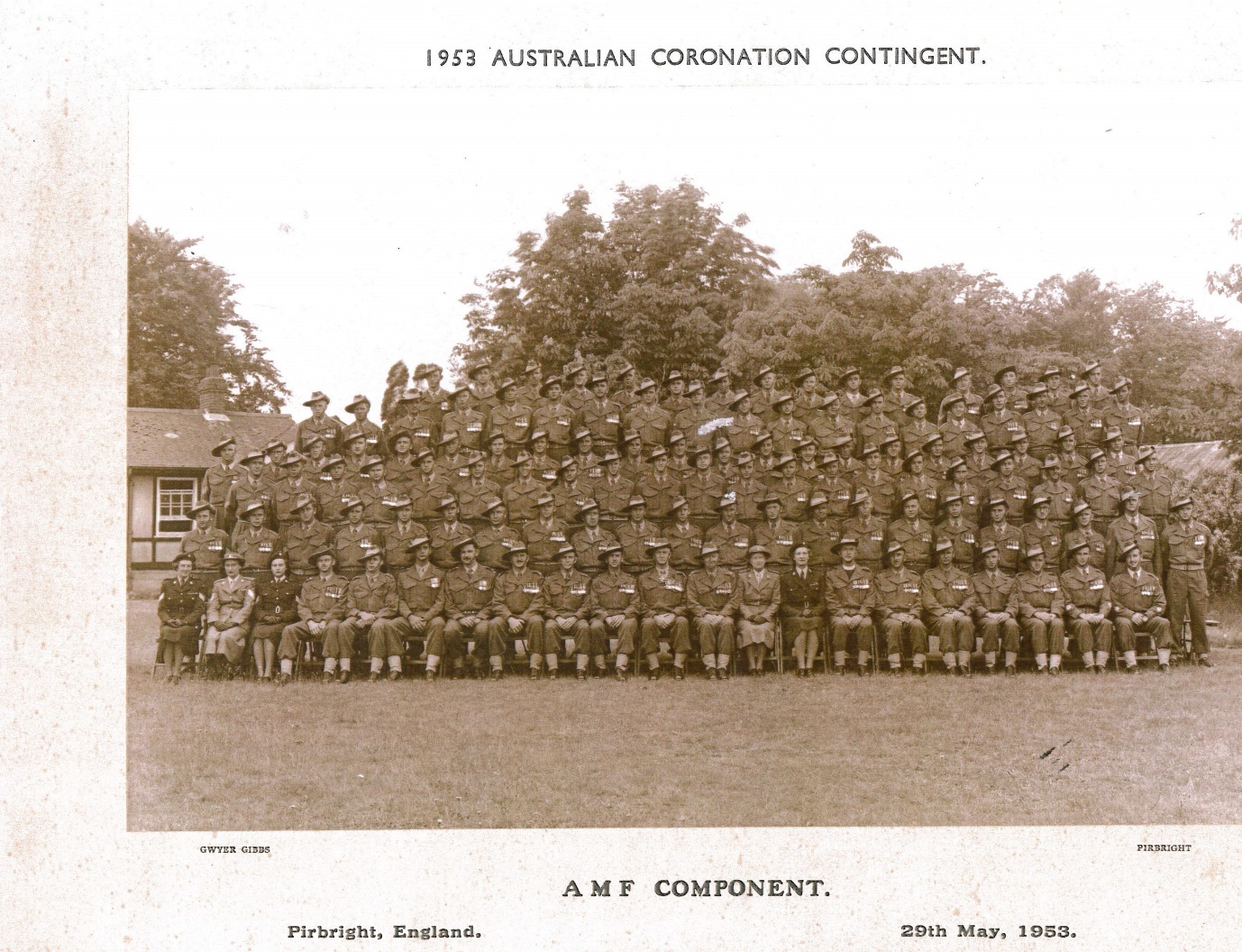
Australian Military Force Coronation Contingent. Geoff is seated front row, 2nd from right.
26 May was a special day for the contingent as they participated in the Guards Parade, taking the handover from the Grenadier Guards in the forecourt of Buckingham Palace. He noted that there was a tremendous crowd and many notaries inside on the forecourt and the Queen and children were at the windows. He also stated that Prime Minister Menzies was very pleased with the performance. Geoff took great pride in the result and he stated “We out-guarded the guards”. As RSM of the contingent, this success can be directly attributed to him.
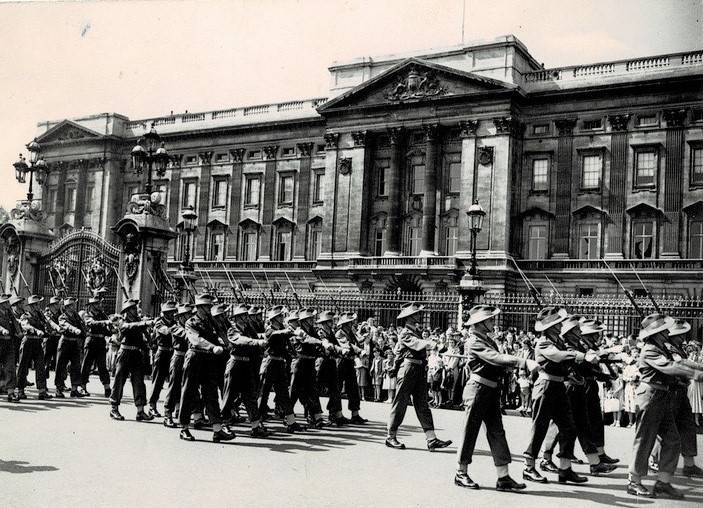
Australian Coronation Contingent parading in front of Buckingham Palace. Geoff is the soldier closest to the camera carrying a pace stick.
The following day, while parading in the rain, the Queen drove past very slowly and waved to them. Geoff wrote, “What a lovely woman she is, so tiny, so graceful and charming. We are certainly blessed with a mighty Queen.” The training continued for several more days until the Coronation Day of 2 June.
Coronation Day was an anticlimax for Geoff. It comprised a morning march to the starting position and then a 20-mile march in wet weather. He stated the Australians were given a great ovation but it was a very tiring day. They had to stand in pouring rain for 15 minutes, soaked and cold. They saw nothing of the Queen or anything else, only the necks of the men in front. The march band was bad, too far away, causing them to be constantly changing step. He saw the whole thing on television that night.
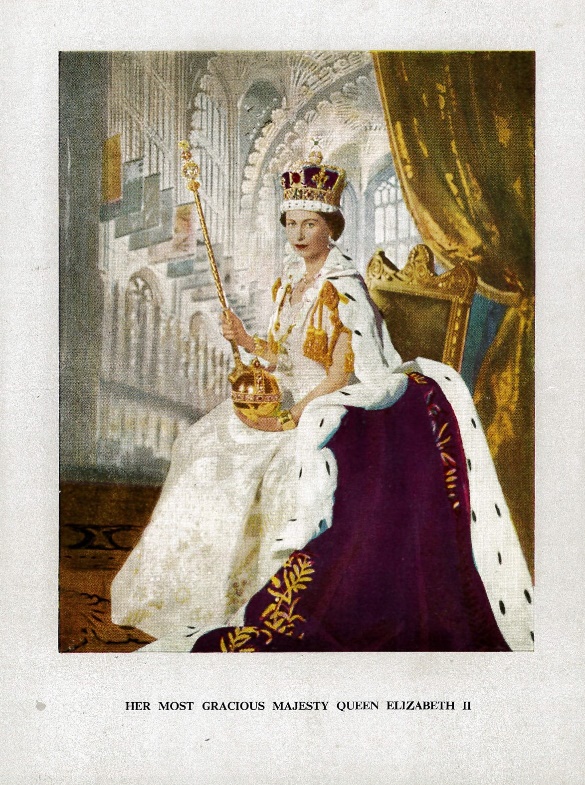
Her Majesty Queen Elizabeth II on Coronation Day.
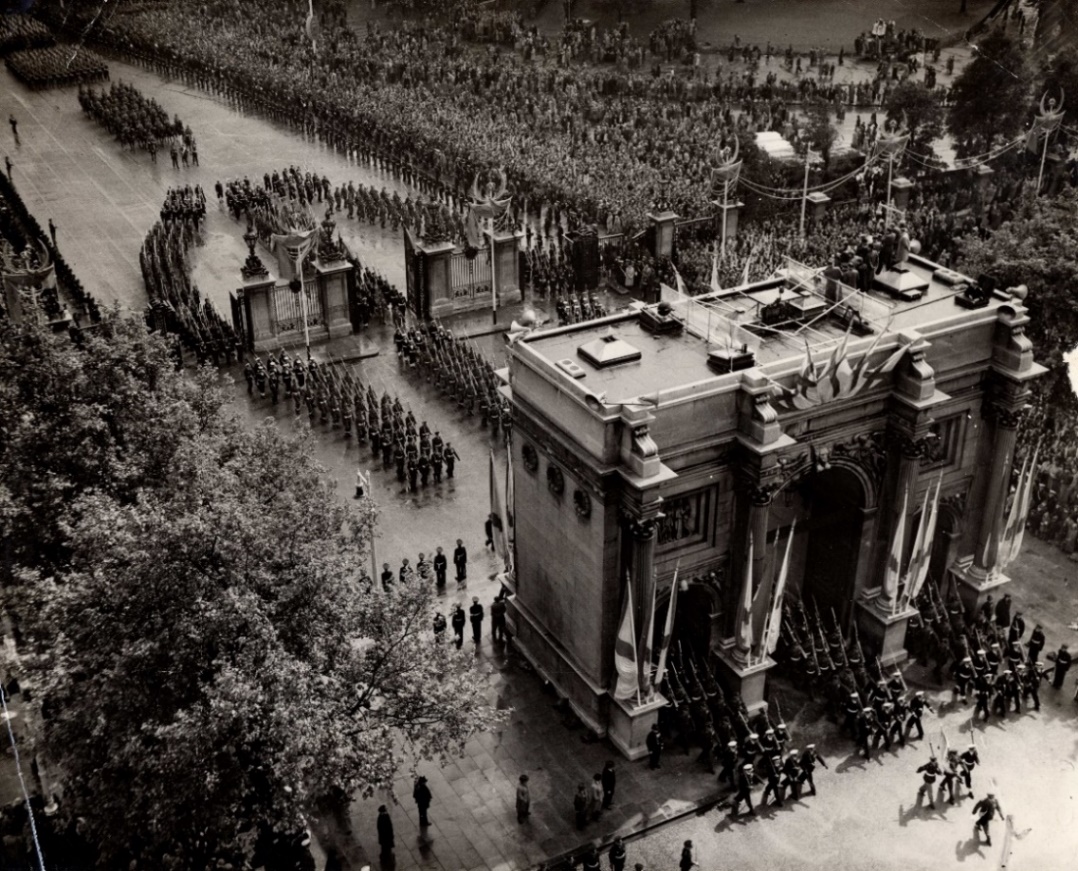
Australian Coronation contingent marching up the Mall.
The following day they were taken to Kensington Gardens to receive their Coronation Medals. The Queen inspected each front rank and Geoff had a good view of her inspecting the Canadians. He wrote, “She is positively radiantly beautiful and very tiny. Phillip with her and they make a wonderful pair. As it was raining, Queen had on top coat of pale blue with small hat tilting well down on head. Princess Margaret on balcony, also Charles and Anne, both lovely children perfectly natural, Anne very blonde. She was laughing and pointing and I heard her say, ‘look at the funny man’ who incidentally was an African Chief.”
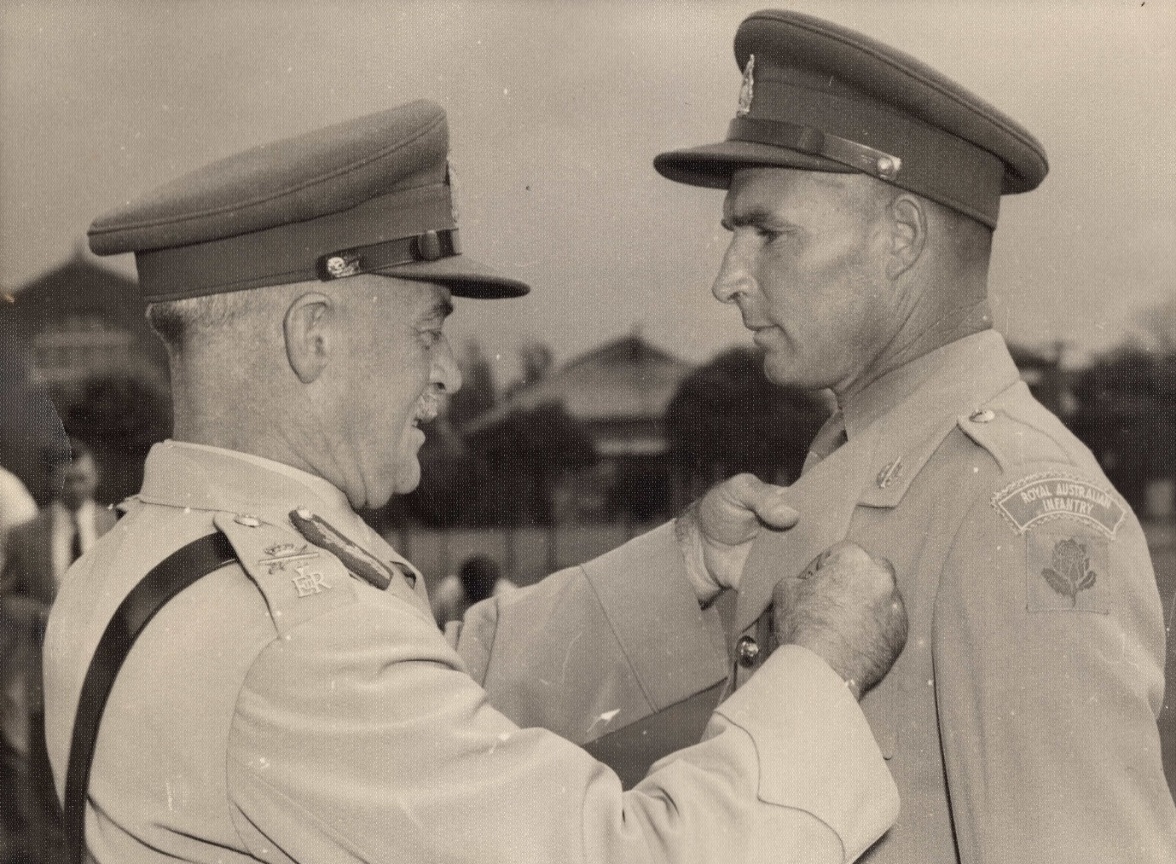
Geoff receiving his Coronation Medal – 3 June 1953
During the next 10 days, Geoff visited highlights of the city and country areas of England, describing quaint villages, grand estates, castles and even Stonehenge. He admitted that by the end of the visit he was getting a little sick of ruins.
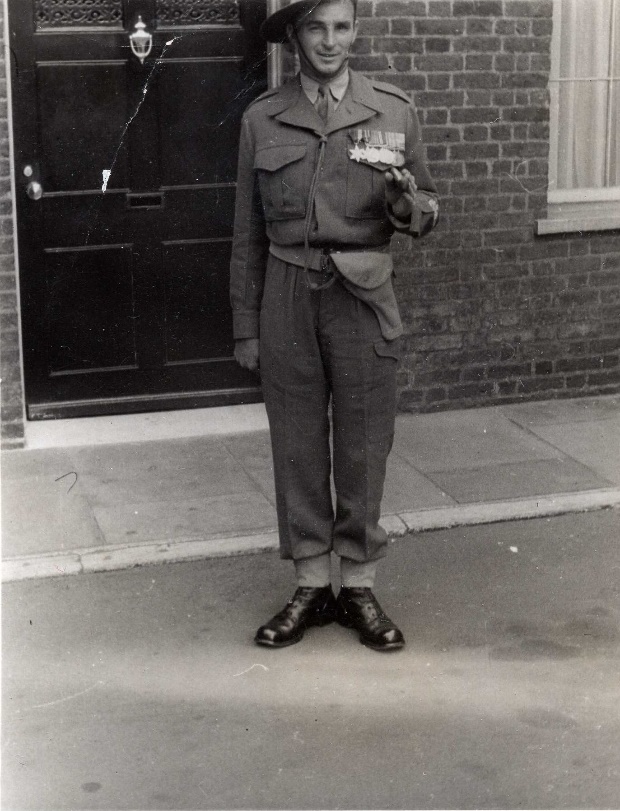
Outside of 10 Downing St, London
Sydney departed Portsmouth on 17 June with the Canadian fleet (HMCS Quebec, HMCS Magnificent, HMCS Sioux and two frigates) bound for Canada and sailed straight into cyclonic weather. The storm conditions were so bad that the fleet broke up with each ship having to make its own way. Geoff’s curse of seasickness returned and he remained ill for five days, not being able to eat at all during that time. He was very pleased when the ship docked in Halifax on June 25.
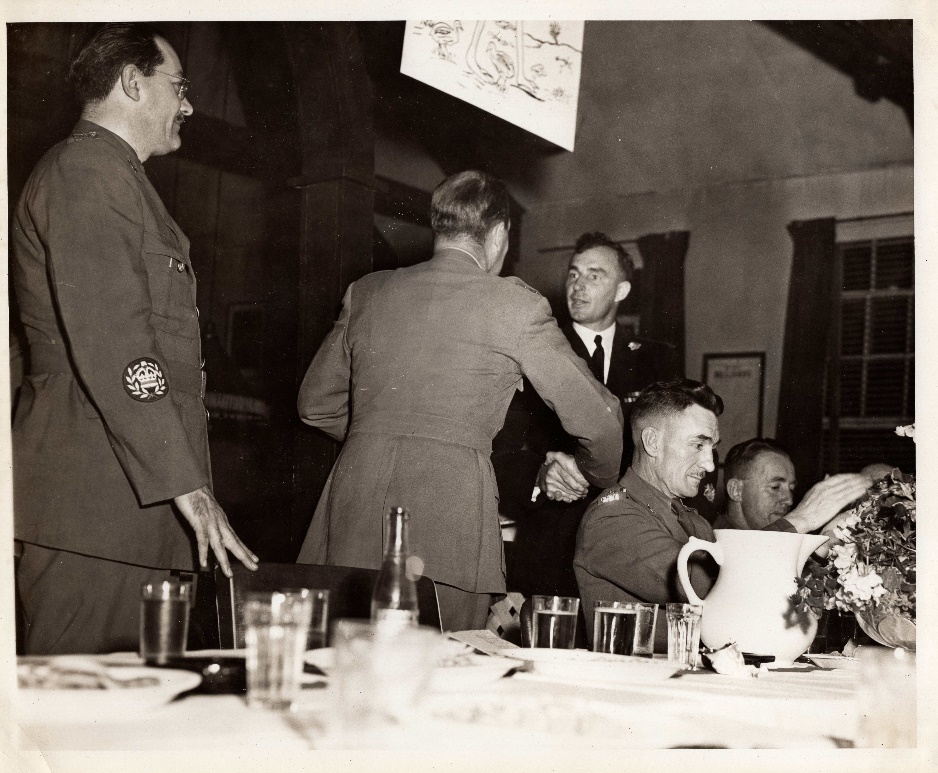
Social occasion in Halifax with Canadian personnel during the Coronation tour
The contingent spent several days in Halifax but Geoff was not impressed with the city. One highlight of the visit however was a catch up with some of the lads he had served with in Korea. The ship departed Halifax on 29 June and sailed to Baltimore.
Arriving in Baltimore on 2 July, the contingent appeared on television and Geoff was interviewed at a local radio station. The day finished with an organised dance. They boarded buses the following day for a tour of Washington which impressed Geoff far more than Baltimore.
The Sydney departed Baltimore on 5 July and headed south into much balmier weather. After a brief stop in Kingston, Jamaica, they traversed the Panama Canal on 12 July. From there they sailed to Pearl Harbour, reaching it on 26 July. After a brief visit and sightseeing, they departed Hawaii on 30 July and sailed for Auckland, arriving there on 10 August. After disembarking the New Zealand contingent, the Sydney then set sail for her namesake city, arriving on 14 August.
Upon arrival in Sydney, a film crew for the prominent news service, Cinematic News, was waiting at the dockside and filmed a very eager soldier racing down the gangplank, across the wharf and into the arms of his loving family while the remainder of the contingent was still at the railings on the higher decks. It was Geoff, keen to greet his wife and son Peter. The film clip was displayed widely in cinemas across Australia.
On 15 August he was detached from the Coronation Contingent and transferred back to HQ 2 Cadet Brigade. He received a Long Service award on 4 July and continued service with 2 Cadet Brigade until 21 June 1960. While in this position, the family again increased in size with the birth of a third son, Roger Ian on 15 June 1955. He also won the Puckapunyal Service Shoot in 1954, proving he was still a highly-skilled marksman.
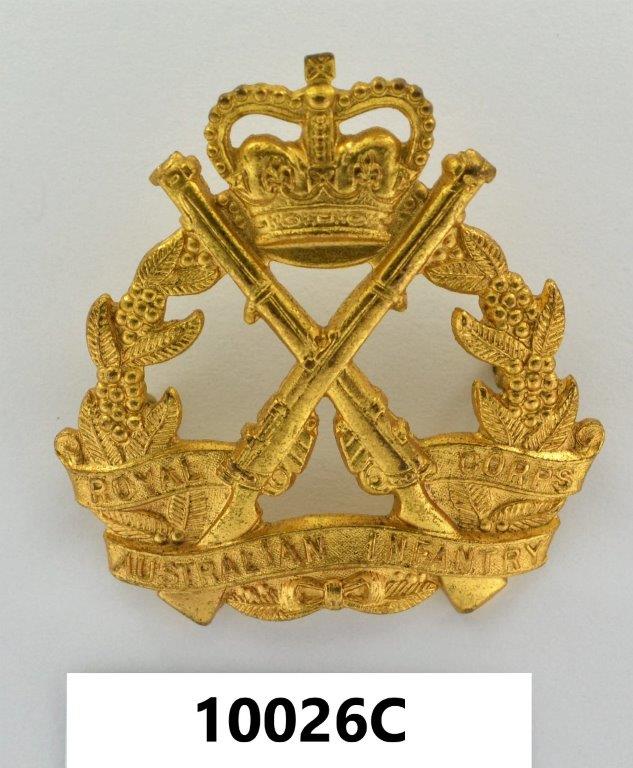
Royal Australian Infantry Corps hat badge
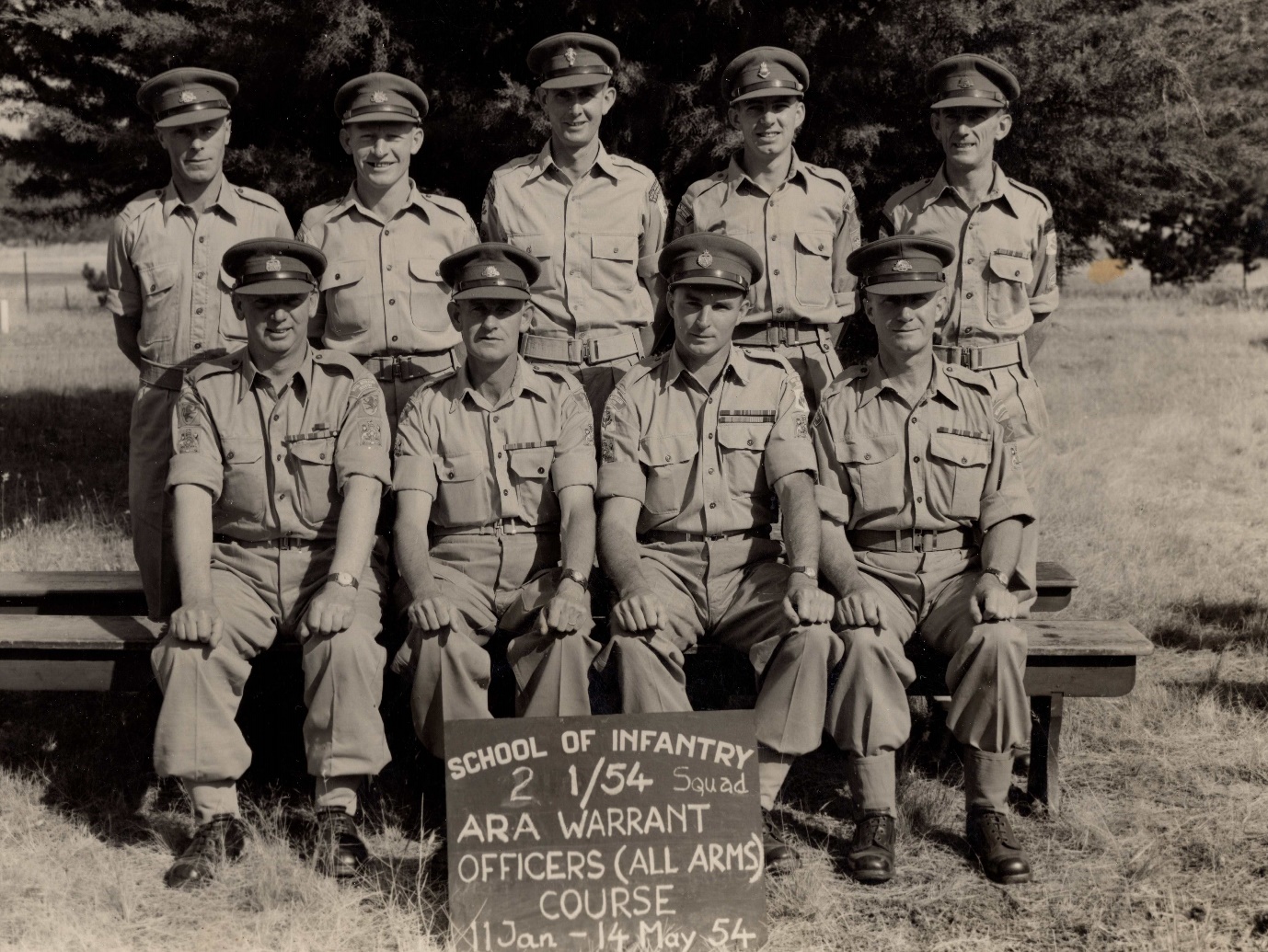
Warrant Officer Course – 1954. Geoff is seated second from right, front row.
Following this assignment, Geoff was discharged from the Regular Army for the purpose of being appointed to commissioned rank. On 22 June, he received a commission and began serving as a 2nd Lieutenant in the Royal Australian Infantry.
Geoff was then offered a choice of Rockhampton or Launceston for his next posting. He chose the position of Adjutant of the Launceston Company , 1 Royal Tasmanian Regiment (1 RTR) at Patterson Barracks and took up his duties there on 30 October 1960. He was appointed honorary captain in this position on 21 December. The family transferred to their new home at 3 Robin St, Launceston. Geoff was sent for NBC training at the Infantry Centre, Singleton from 7 June to 27 June 1961.
While in Launceston, Geoff struck up a close friendship with Captain Gordon John Fitzgerald of 112th Field Battery, Royal Australian Artillery. Like so many of Geoff’s acquaintances, Gordon went on to complete a long and distinguished army career, culminating in the rank of major general and the position of Chief of Army Personnel.
Geoff was promoted to 1st Lieutenant on 22 June 1962 but continued serving with 1 RTR as an honorary captain until 11 September 1963 when he was again posted overseas, this time to Singapore. He was attached to Far East Land Forces (FARELF) based at Tanglin Barracks. The posting resulted in another family move to a new home at Thompson Rise Estate and later to 236 Dunearn Road, Dunearn Park, Singapore.
This time however, the family was split as their eldest son Peter was unable to accompany them. He had reached his final secondary school year and it was deemed by the army that he should remain in Australia. Peter moved in with his grandparents in Sydney while the rest of the family relocated to Singapore. The Indonesian Confrontation was at its peak and his son Roger remembers the nightly curfew imposed on the citizens of Singapore at the time. He also remembers Geoff, now almost 50 years of age, winning the veterans swimming race, despite being given a time handicap.
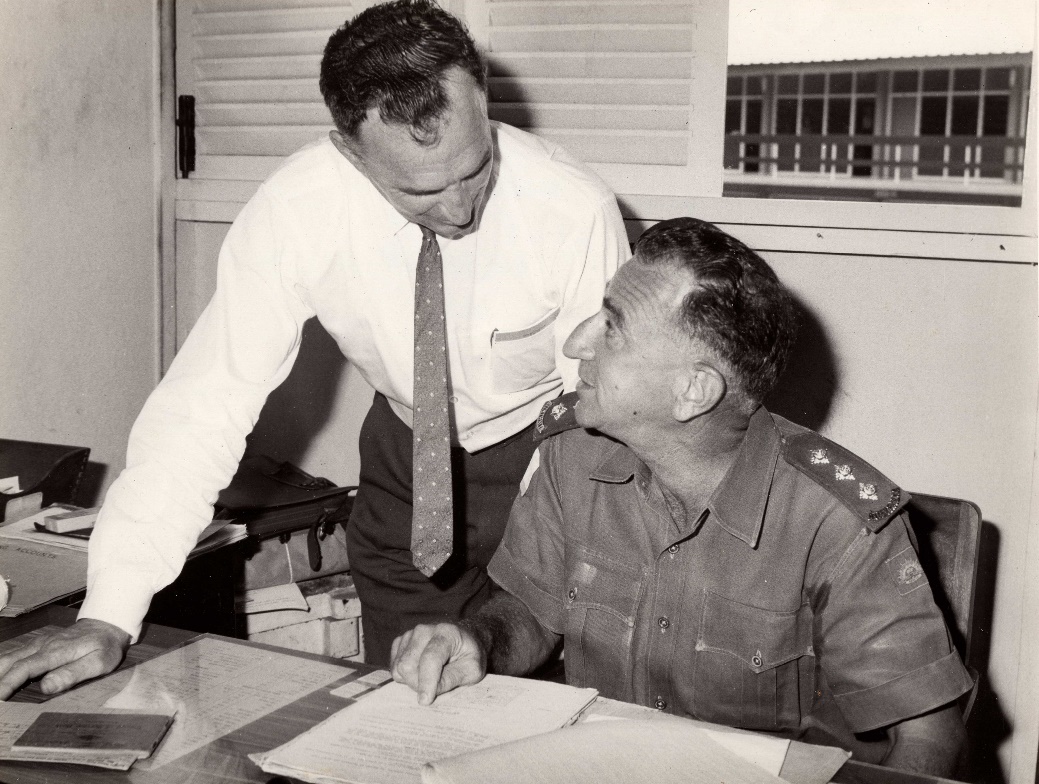
Handover from Captain Neil Anderson to Geoff upon taking up his post in Singapore.

A happy reunion – Geoffrey (centre) with two colleagues who served with him in the Darwin Mobile Force (DMF) during World War 2. They are Major Cliff Johnson (right) and Captain Keith Kennedy (left). The trio had not met since their time in the DMF.
At this time, the US involvement in the Vietnam War was becoming more prominent and the Australian Government was assessing whether Australia should also become involved and, if so, to what extent. To assist with this analysis, on 15 September 1964, Geoff was flown to Saigon and tasked to compile a report highlighting the methods being used by South Vietnam and the US to prosecute the war.
For nine days, from 15 September to 24 September, he visited several encampments and accompanied an ARVN unit and their US advisers as they patrolled their area of responsibility. The resulting report was blunt, hard hitting and damning of the way the war was being conducted. He stated:
In general, the tour is of immense value as it permits those participating to gain first-hand knowledge of problems which must be seen to be believed. Three basic factors appear to emerge from my personal observation. These are:
- The magnitude of the task of eliminating the VC element
- The apparent apathy of the people of Vietnam generally
- The keenness of the advisers to get on with the job.
He first visited the Australian embassy for a briefing and then HQ US Military Assistance Command in Saigon to gather data regarding the estimated size and composition of the enemy forces and the plan being implemented to defeat them. He was impressed with the presented plan to clear VC occupied areas, secure these areas from future incursions and then develop them by strengthening government structure and aiding the economy. He was advised by General Westmoreland that the plan had begun to be implemented. As a result, the VC were very angry and were increasing their disruptive activities.
Geoff visited several hamlets and started gaining an understanding of the real problems on the ground. Some of the hamlets he visited were in much better condition and more prosperous than others. When he enquired why, he was simply told that the hamlet leaders paid the VC to leave them alone so they could prosper – a disturbing situation. The tour concentrated on Phuoc Tuy province and Vung Tau, both of which would feature prominently in Australia’s role in the war in later years.
He accompanied a South Vietnamese unit (38th Ranger Bn) on a ‘Clear and Destroy’ mission aimed at ridding the target area of VC. He was very critical of the operation. His comments on the operation include the following:
- Very poorly executed operation.
- No formations, no thorough searching on either side and overhead, weapons not prepared or carried in a manner to enable immediate fire if necessary.
- Bunching of troops consistent. Too much noise, troops smoking and talking.
- Leading scouts only 5 to 10 metres from main party.
- Though clear signs of enemy observed, no attempt made to make contact.
- No side tracks checked.
- Discipline very poor.
- No blocking forces.
He noted that it was most noticeable when signs were seen of recent enemy activity, the noise of the troops increased considerably, obviously to ensure that the enemy knew a large force was participating in the operation, thus minimising the chance of ambush or fire being brought down.
During this exercise, the helicopter that Geoff travelled in received heavy fire, highlighting the danger he was constantly in.
He concluded that at any time a small VC element could have caused considerable casualties.
His summary states that although the South Vietnamese forces are well equipped, they avoid night patrols, lack discipline and have not been taught many of the rudiments of warfare. His summary of the VC forces was much more complementary.
Interestingly, he concluded from this that it would be a wonderful opportunity for Australian troops as the country lends itself to infantry tactics. He suggested that as many infantry officers as possible should get an opportunity to see what he had seen. He considered the most interesting area to be the Delta region as the type of country is completely new to Australian troops and the methods of fighting and holding in this type of terrain presents many problems which require to be seen to be believed.
His report appears to have influenced the Australian Government and Army as Australian troops were subsequently sent to operate in Phuoc Tuy province in the Delta area and their supply base would be Vung Tau.
He returned to Singapore on 24 September 1964.
Geoff’s Army record makes two mentions of him being attached to Special Services Malaysia but no detail is included to describe his activities in this role. Although Geoff must have performed service in Malaysia during this time as he was awarded the Pingat Jasa Malaysia medal, in addition to Malaysia clasps to other medals, there is no mention of his specific role in his army records. He performed the role from 7 July 1965 until 5 December 1965.
The time in Singapore for Geoff and his family came to an end on 8 December 1965 and they boarded the P&O cruise ship SS Orsova bound for Sydney. The ship visited Fremantle on 11 December and reached Sydney on 17 December. He was again posted to Canberra in the role of quartermaster and on 24 February 1966 was placed on higher duties with the pay rate of major. The new address for next of kin as noted on the Army record is 15 Dunstan St, Curtin ACT.
Geoff had always attended regular medical check-ups but in that year the army missed one which was to have grave consequences. On 20 August 1966, while playing golf, he suffered a major stroke and was admitted to Canberra Community Hospital. He remained there until 29 August when he was transferred to Royal General Hospital Concord. His condition improved somewhat and on 2 September he was removed from the seriously ill list but remained in hospital for three and a half months before being discharged on 13 December.
The damage from the stroke however was lasting and extensive. It had paralysed the left side of his body. After much physiotherapy, he regained some independence and learned again how to drive but his ability to continue in the army was severely limited.
He returned to work and remained in service until 22 December 1967 when he was medically discharged. He was also granted the military title of major with permission to wear the prescribed uniform. Geoff’s long and distinguished career in the military service of Australia had come to an end.
The Geoffrey Hart Pace Stick
An essential item carried by all RSMs in the Australian Army is the pace stick which originated in the artillery as a ‘Gunners Stick’ used to measure the distance between guns. It was later adapted to measure the length of the pace taken by soldiers to get them all pacing the same. The pace stick is actually two pieces of timber, hinged at the top and able to be set to a particular distance, similar to a compass used for geometry at school.
The pace stick is two things.
Firstly, it is an indicator of rank – only the RSM carries a pace stick.
Secondly, it is used to measure distance, most commonly the pace of a marching soldier although it is also used by the RSM when laying out marker points on a parade ground so that troops turn and finish up at the correct point during ceremonial parades.
After his retirement from the Army, Geoff presented the pace stick he carried as RSM of 3 RAR to the current leadership of 3 RAR. It was warmly appreciated and he received a note from the current RSM, WO1 Noel Smith, thanking him for the pace stick.
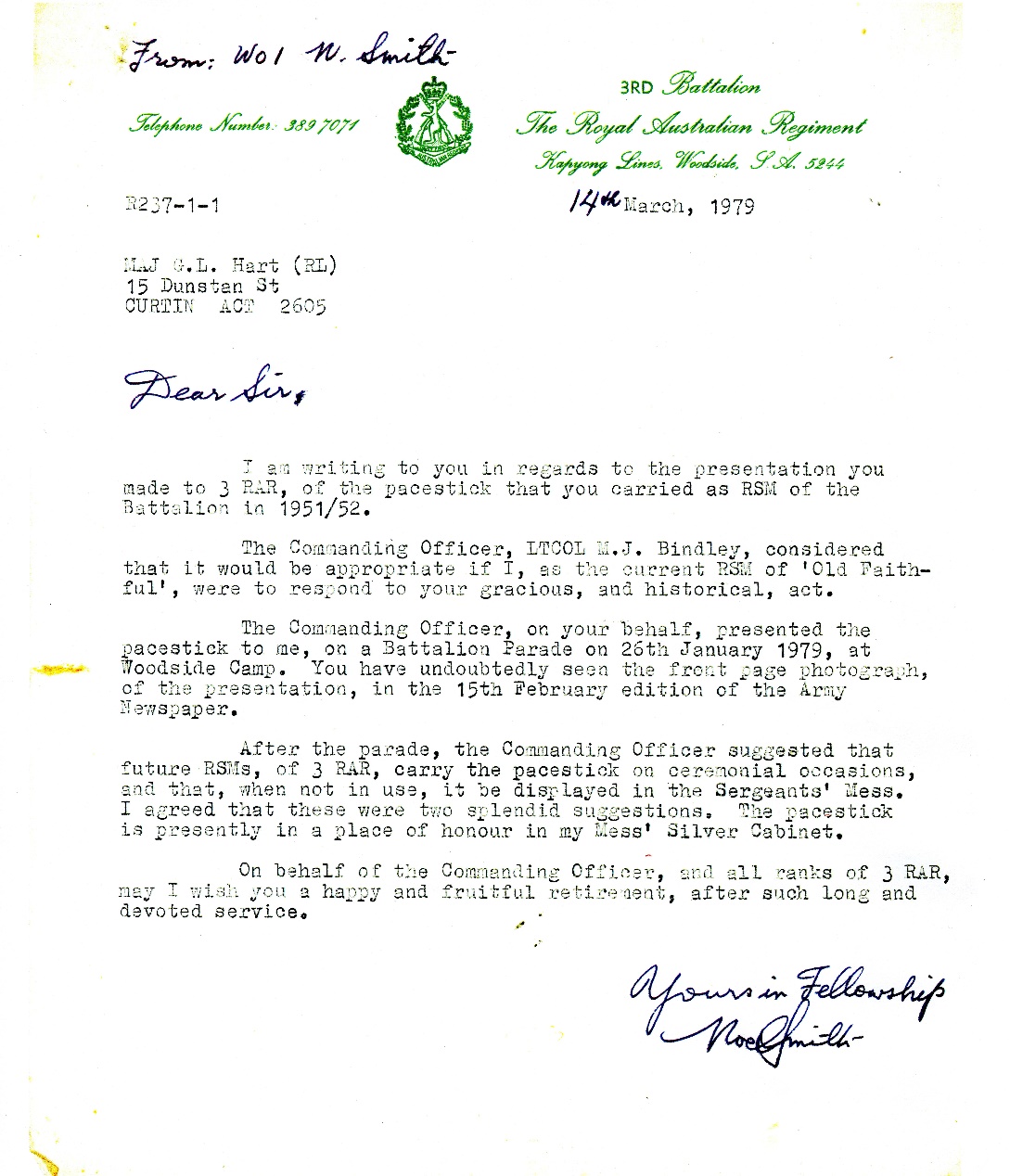
Note of appreciation from the RSM of 3 RAR received by Geoffrey upon the presentation of the pace stick used by him when he held the same position.
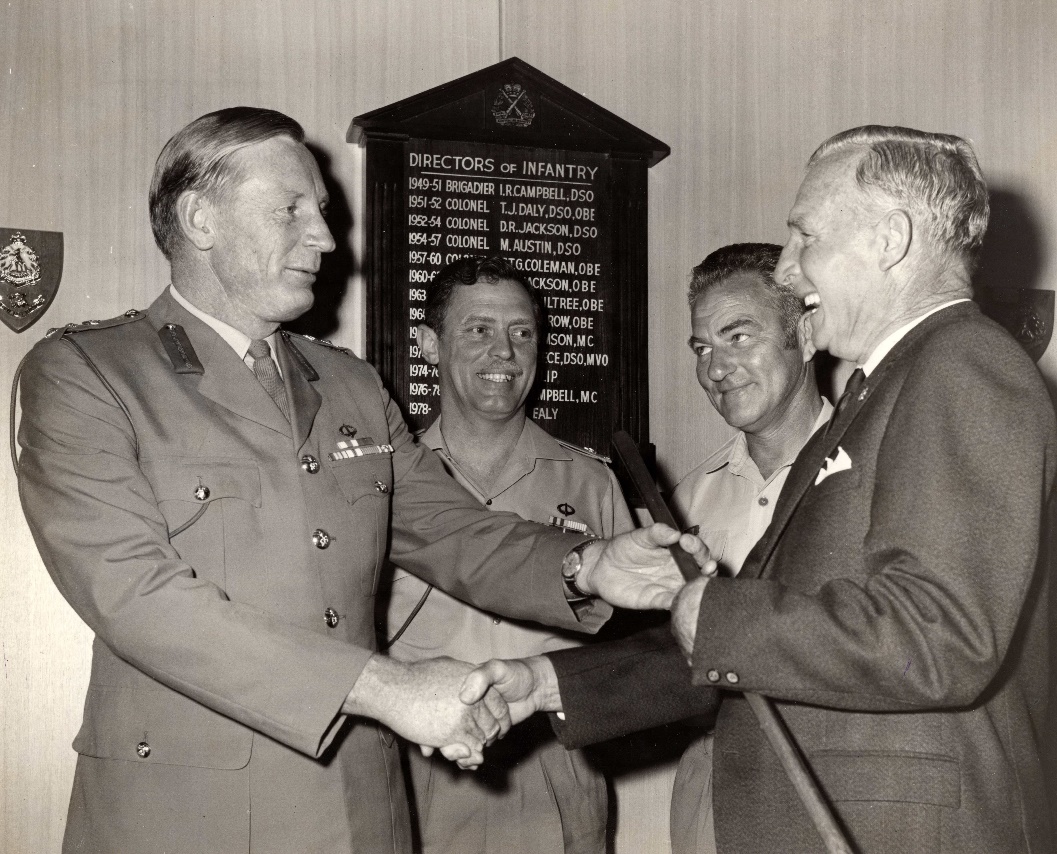
Presentation of the pace stick used by Geoff while RSM of 3 RAR in Korea to current members of 3 RAR.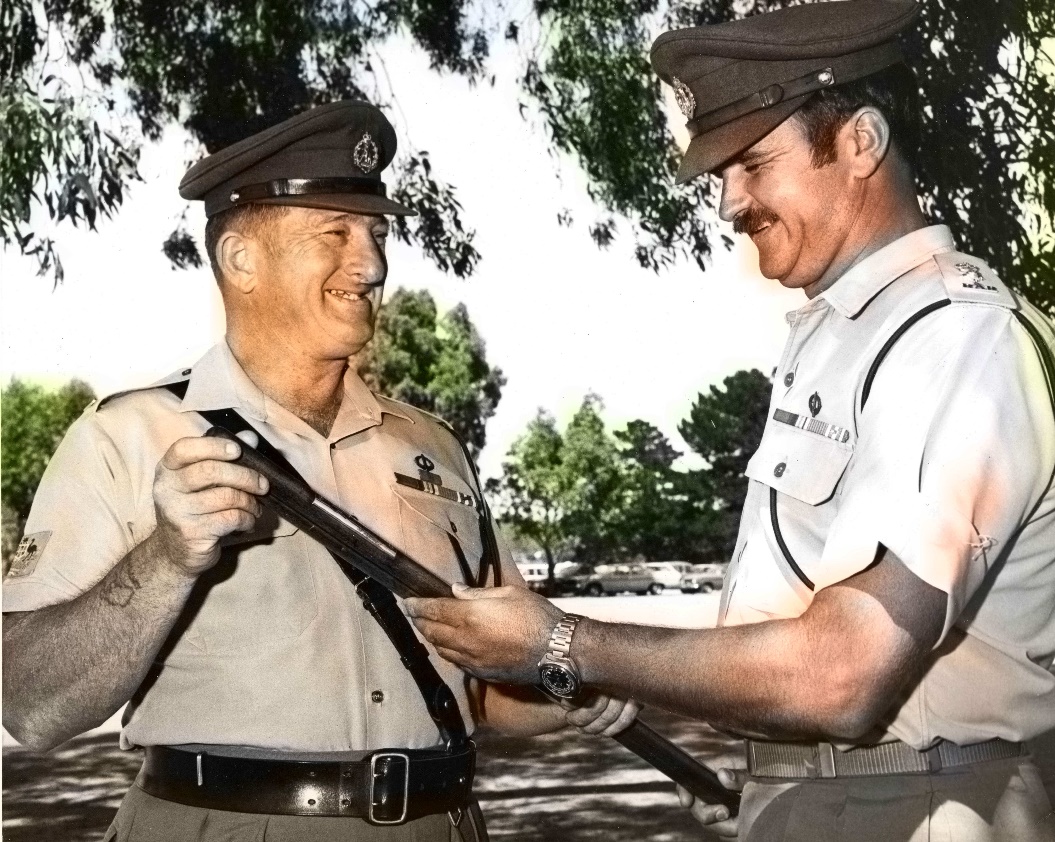
The Geoffrey Hart Pace Stick being inspected by the CO of 3 RAR, Lt Col Michael Bindley on the occasion of the 3 RAR Battalion Parade (RSM’s Parade) on 26 January 1979. Holding the pace stick is the 3 RAR RSM Noel Smith.
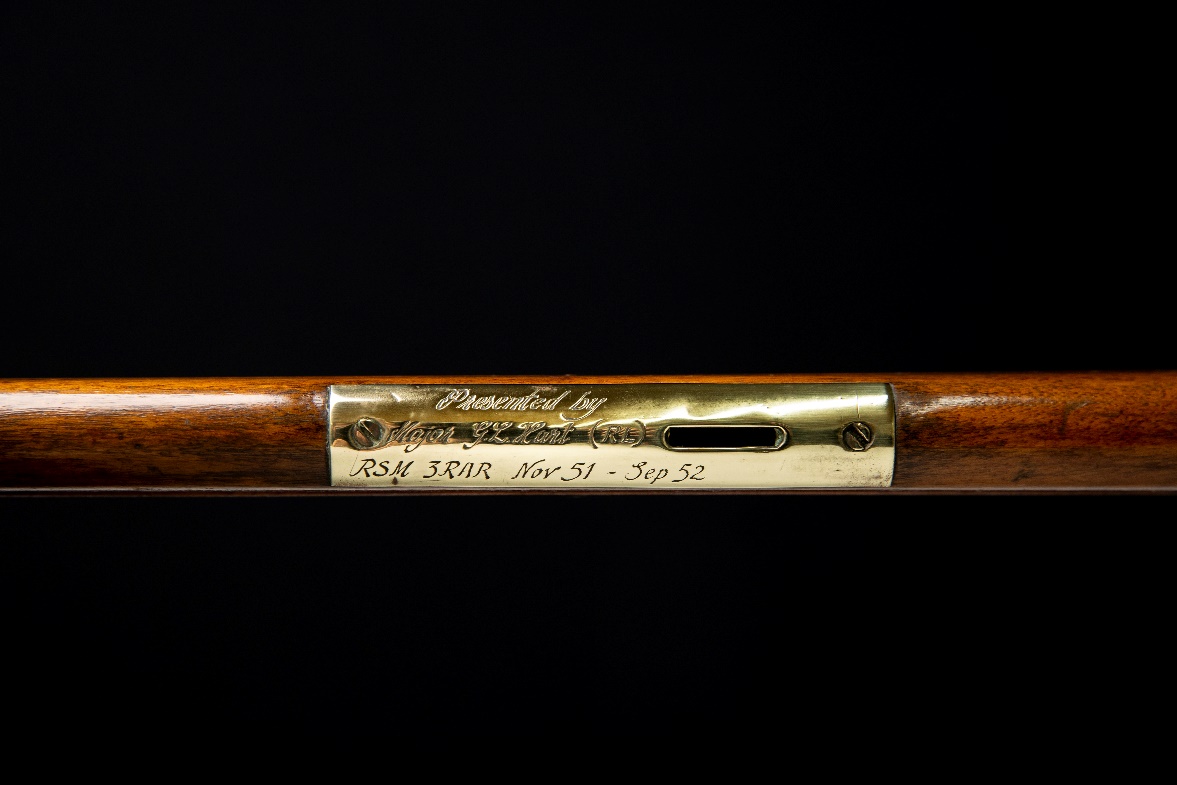
Engraving on the pace stick presented by Geoff to 3 RAR

Full view of pace stick
After returning from Korea, 3 RAR was based in Ingleburn, Sydney until October 1959 when it relocated to Enoggera, Brisbane. It then moved to Woodside, near Adelaide in 1963 where it was stationed until 1981. It was during this time the pace stick was donated to the battalion with the agreement that it would be used on ceremonial occasions.
The battalion however, was not destined to remain stationery and was relocated to Holsworthy, near Sydney in 1981 and then to Townsville in 2011. Sometime during this period, the pace stick ‘disappeared’, not surprising considering the dual relocation. In the meantime, another pace stick was donated to 3 RAR by the O’Sullivan family and was used on ceremonial parades. WO2 J B O’Sullivan was RSM of 3 RAR from December 1954 to March 1955 and again as WO1 (MBE) from October 1959 to July 1962. It was highly likely that he and Geoffrey would have been acquainted.
As part of the preparation of this biography, Geoffrey’s son, Peter, contacted the current RSM of 3 RAR, WO1 Adam West and provided him with information and photos of the pace stick. This contact resulted in a search by 3 RAR and the subsequent rediscovery of the Hart pace stick. Peter has now been advised by Adam West that the Hart pace stick will be reinstated and again carried by the RSM on ceremonial parades. The only exception to this will be Kapyong day when the O’Sullivan pace stick will be carried.
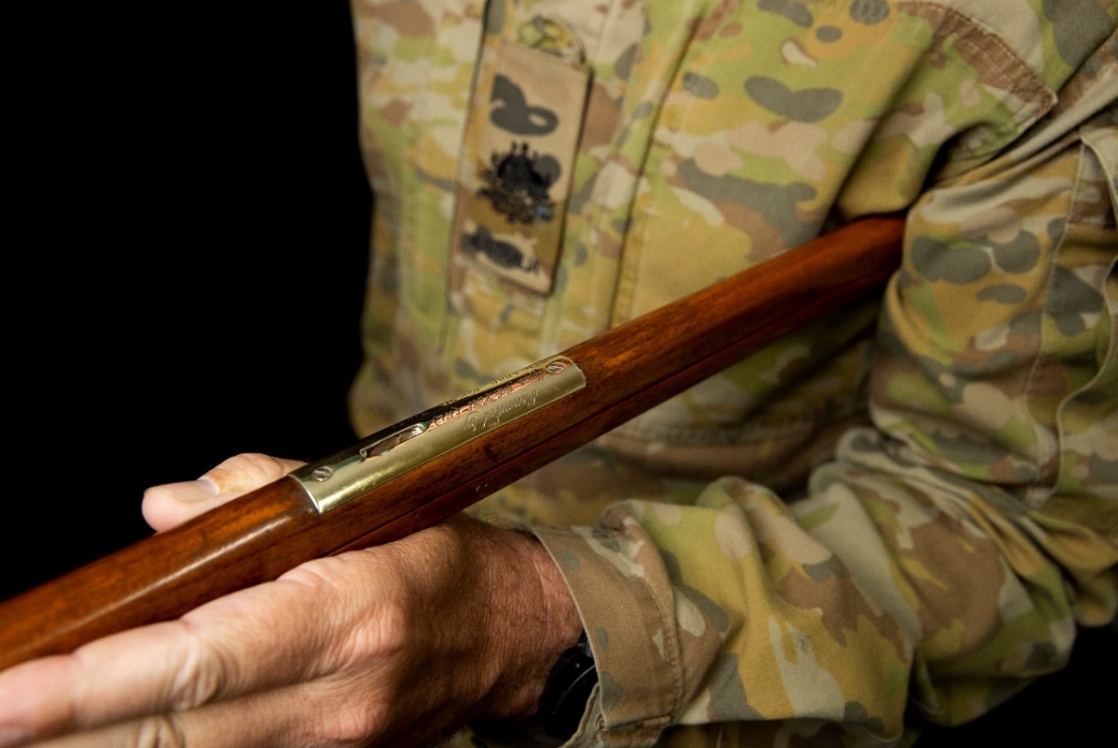
The Geoffrey Hart pace stick in the hands of the current RSM of 3 RAR (Adam West – DSM) at Lavarack Barracks in Townsville. When Adam was asked if it was really him holding the pace stick, he replied, “Yes, that’s me, but the pace stick is forever”, meaning, it doesn’t matter who’s holding the pace stick, because it’s only the pace stick that’s important in the long run.
The Hart pace stick has an amazing history. General Sir Francis Hassett mentioned it in his following quote:
I still have a mental picture of him appearing on daily rounds (we were living in holes) – smart looking, carrying a pace stick and very well received by the soldiers.
This tribute referred to Geoffrey’s approach and outlook while in the active war zone in Korea. Following Korea, the pace stick accompanied Geoffrey on the coronation tour. He can be seen carrying it in a picture elsewhere in this biography. It is likely the pace stick was also used in other units where Geoffrey was RSM prior to 3 RAR which would make it unique. It is truly an exceptional artifact linked to Geoffrey’s career.
Geoffrey’s retirement from the army did not mean the end of his achievements. He called upon his talents as an artist and created a number of drawings and paintings. He was also the inaugural president of the Canberra Stroke Club and treasurer of Hawks Junior Rugby Union Club. He remained in Canberra until his death on 14 May 1999.
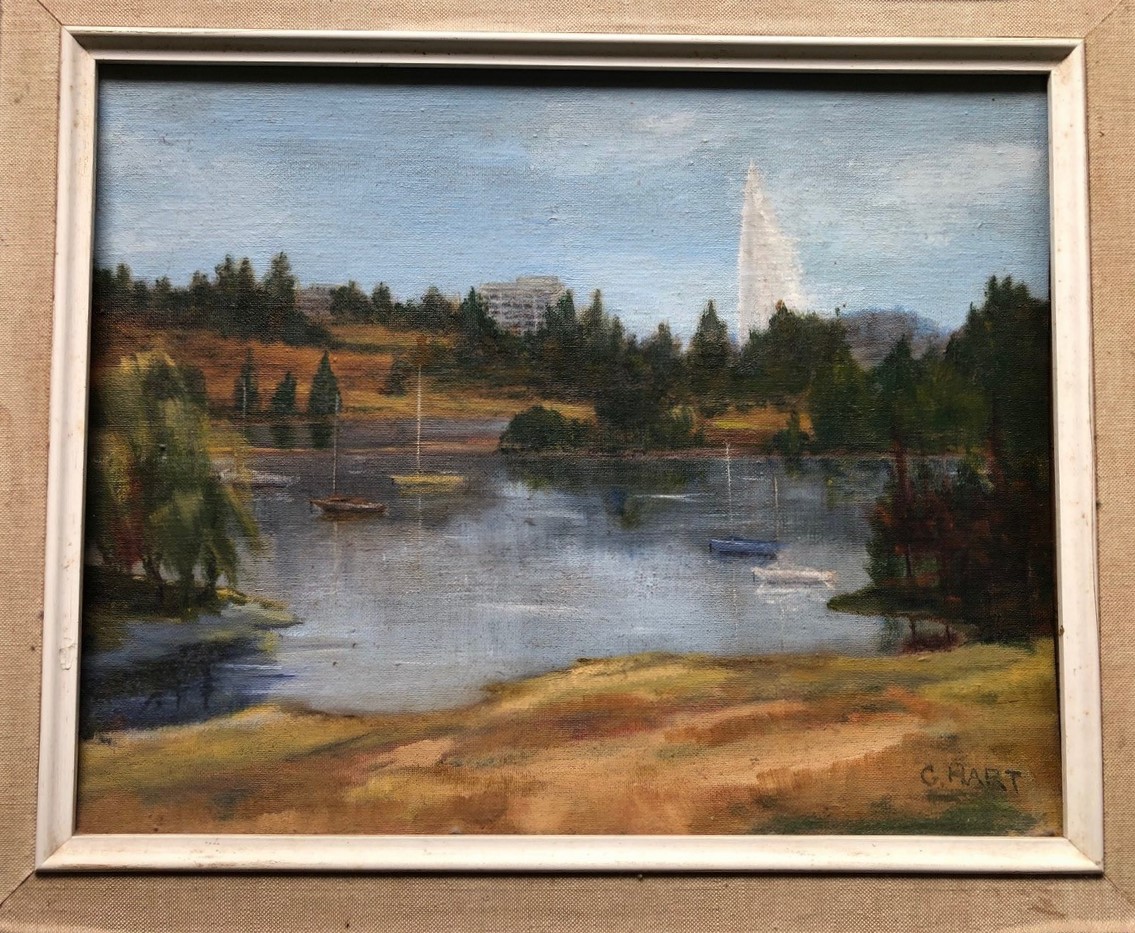
Painting of Lake Burley Griffin, completed by Geoff after his retirement.
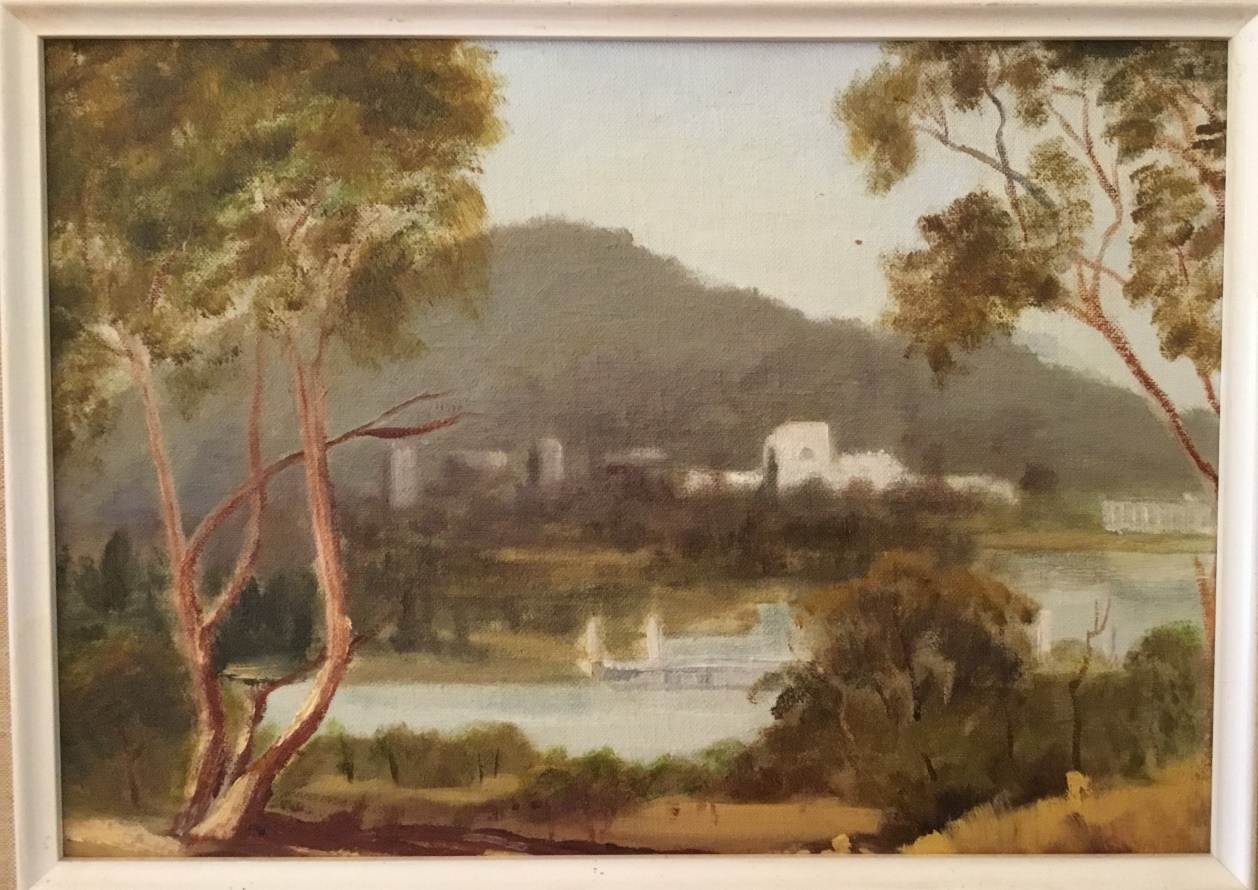
Painting of the Australian War Memorial completed by Geoff after his retirement. This painting is titled ‘Memories’, an apt title for the subject.
During his career, Geoff was awarded the following medals:
- 1939/45 Star
- Pacific Star
- Defence Medal
- War Medal 1939-1945
- Australia Service Medal 1939-45
- Australia Active Service Medal with clasps ‘KOREA’, ‘MALAYSIA’, ‘VIETNAM’
- Korea Medal
- United Nations Service Medal for Korea
- General Service Medal 1962 with Clasp ‘MALAY PENINSULA’
- Vietnam Logistic and Support Medal
- Australian Service Medal (ASM) 1945-75 with Clasp SE ASIA
- Queen Elizabeth II Coronation Medal
- Australian Defence Medal
- Medal for Long Service and Good Conduct
- Pingat Jasa Malaysia
- Republic of Korea War Service Medal

Medal set of Geoffrey Leonard Hart. His family has generously loaned the set for display to the Maryborough Military and Colonial Museum.
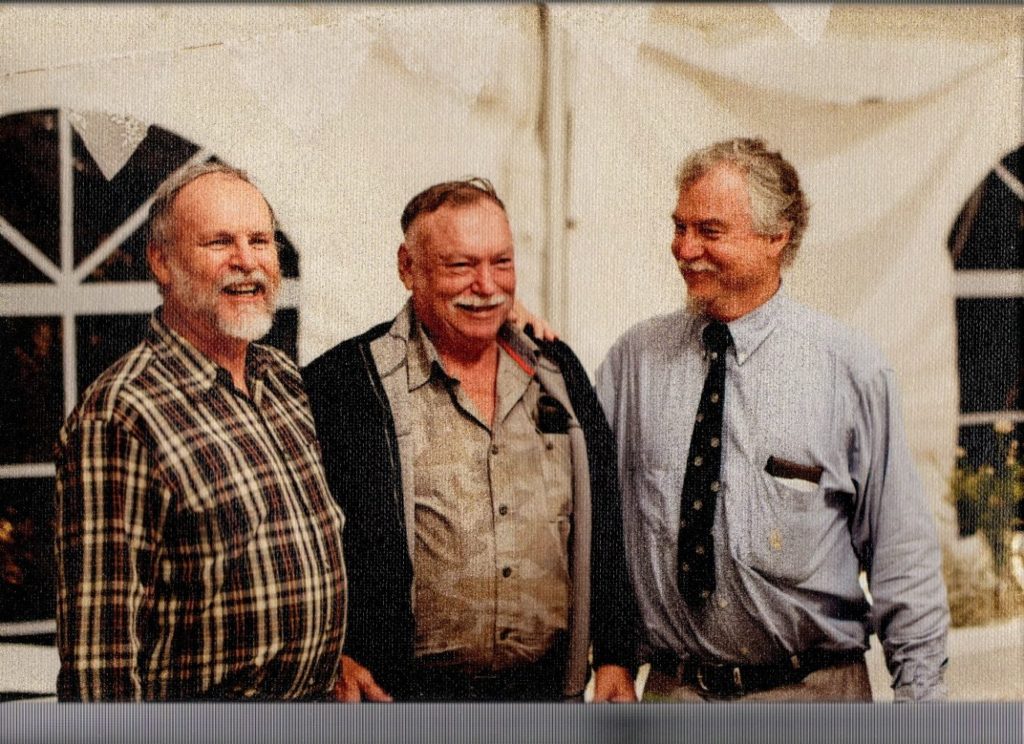
- Geoff’s three sons, from left, Keith Geoffrey, Peter John and Roger Ian.
This project was initiated by Peter Hart in conjunction with the Maryborough Colonial and Military Museum but would not have been possible without the collaboration of all three of the sons of Geoffrey Leonard Hart.
- Bibliography
- National Archives Australia – War Service Record – NX171160 HART Geoffrey Leonard
- National Archives Australia – War Service Record WW1 – Oscar Herbert Hart
- Australian War Memorial, Canberra – War Diary of the Sixth Australian Machine Gun Battalion Extract provided by 6 (Aust) MG Battalion (AIF) Association
- Norman Bartlett – With the Australians in Korea – Australian War Memorial, Canberra 1960
- John Campbell – Machine Gunners – a history of 6 Australian machine-gun Battalion, Loftus NSW 2007
- Time-Life Books – Australians at War – Korea the Forgotten War 1989
- Wikipedia – Sir Francis George ‘Frank’ Hassett
- Geoffrey Leonard Hart – Diary of WO1 Geoffrey Hart RSM – Australian Coronation Contingent 1953
- Geoffrey Leonard Hart – Report – Orientation Visit to South Vietnam 15 Sep 64 to 24 Sep 64 – Geoffrey Leonard Hart 25 September 1964
- Australian Electoral Rolls 1903 – 1980
- Hart Family Records
ANZAC Biographies
On our website you will find the biographical details of ANZAC (as well as British) servicemen & women whose medals or other memorabilia form part of the collection on display at the Maryborough Military & Colonial Museum, Maryborough, Queensland, Australia.